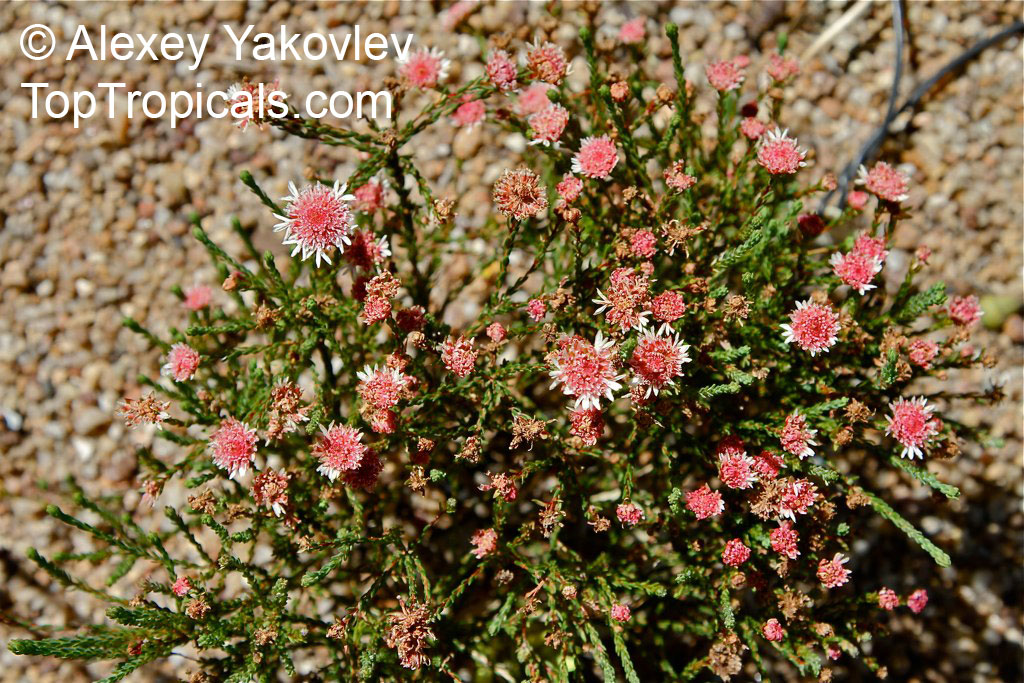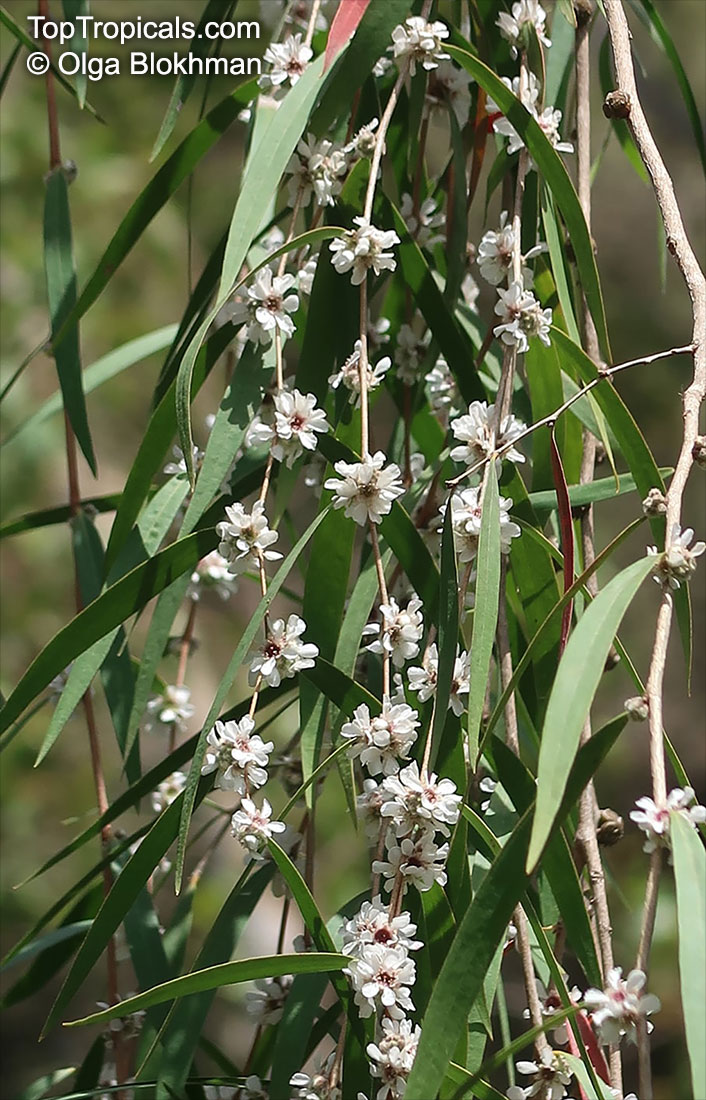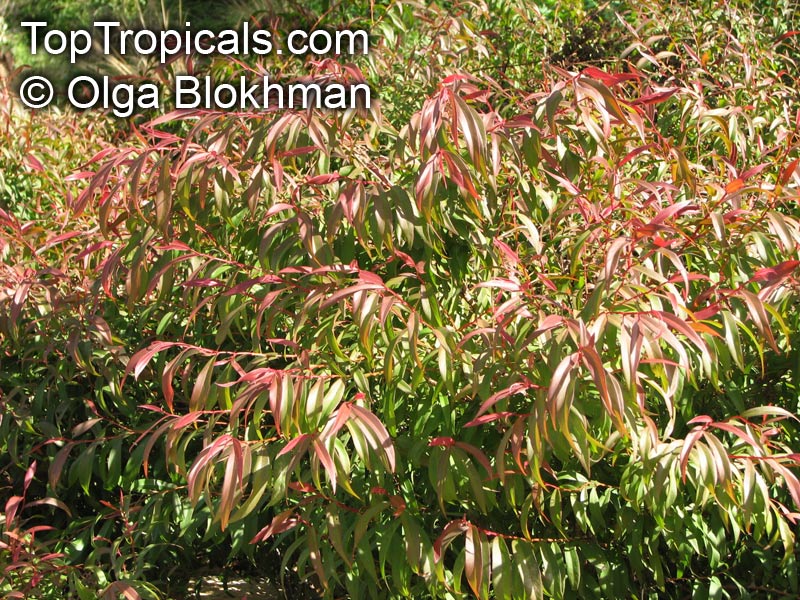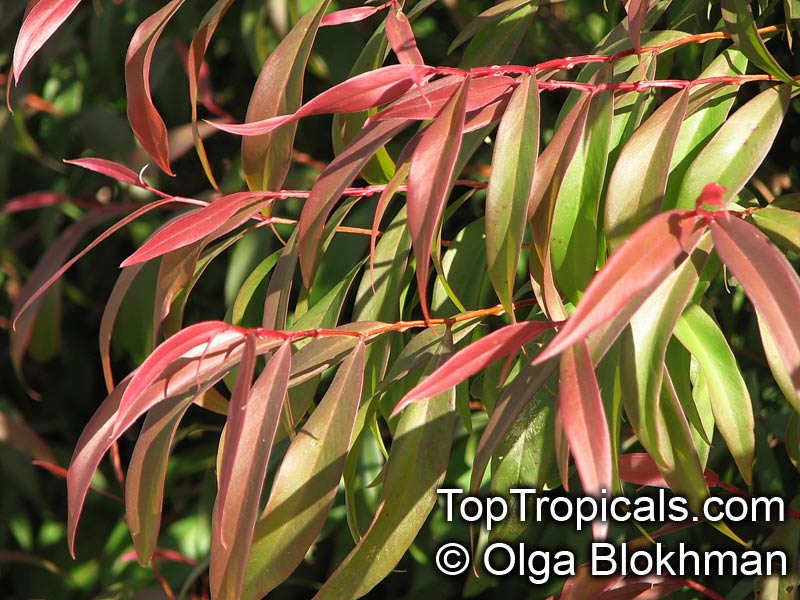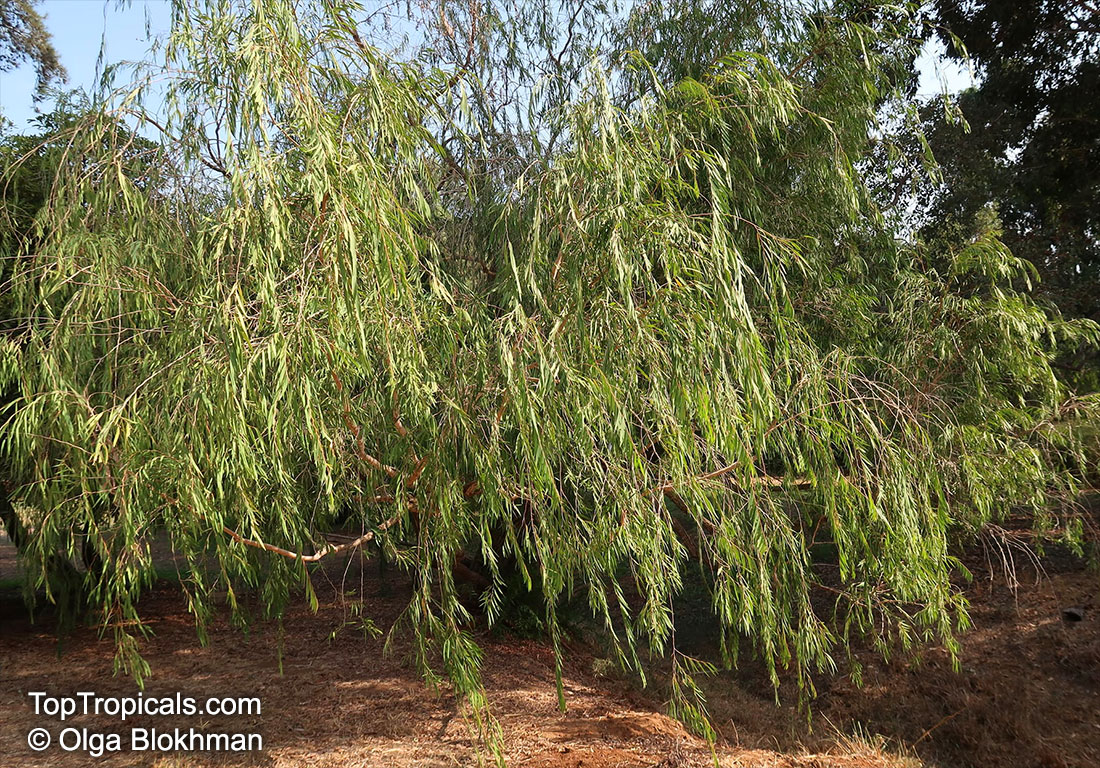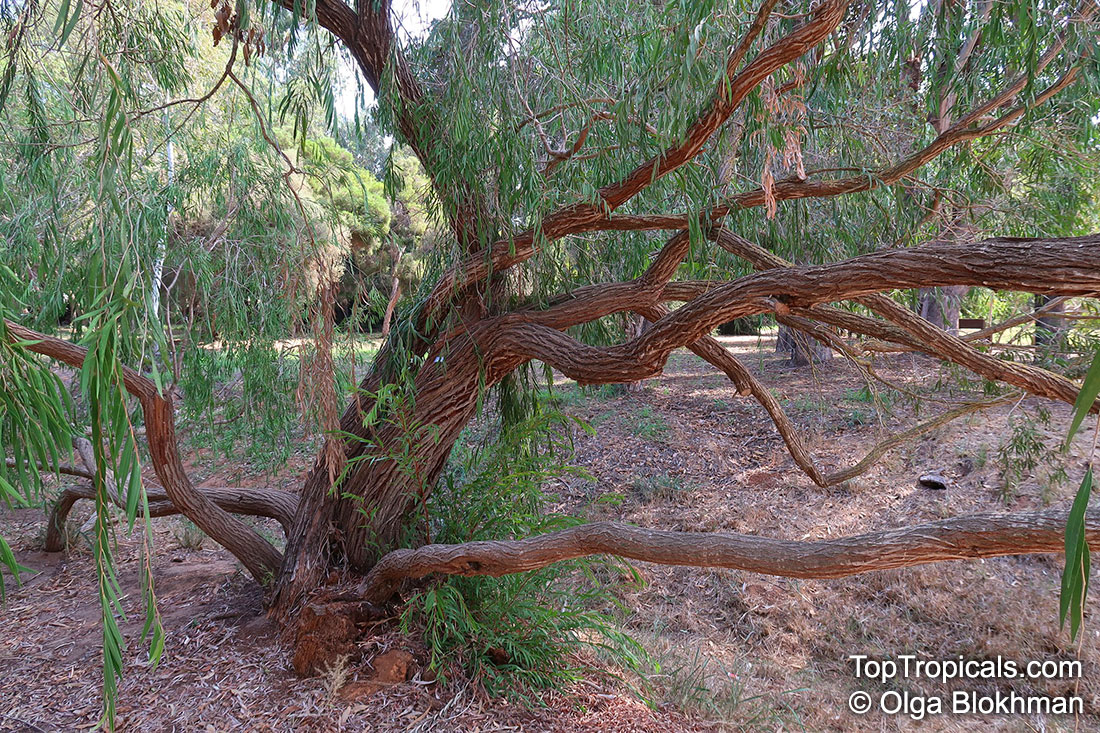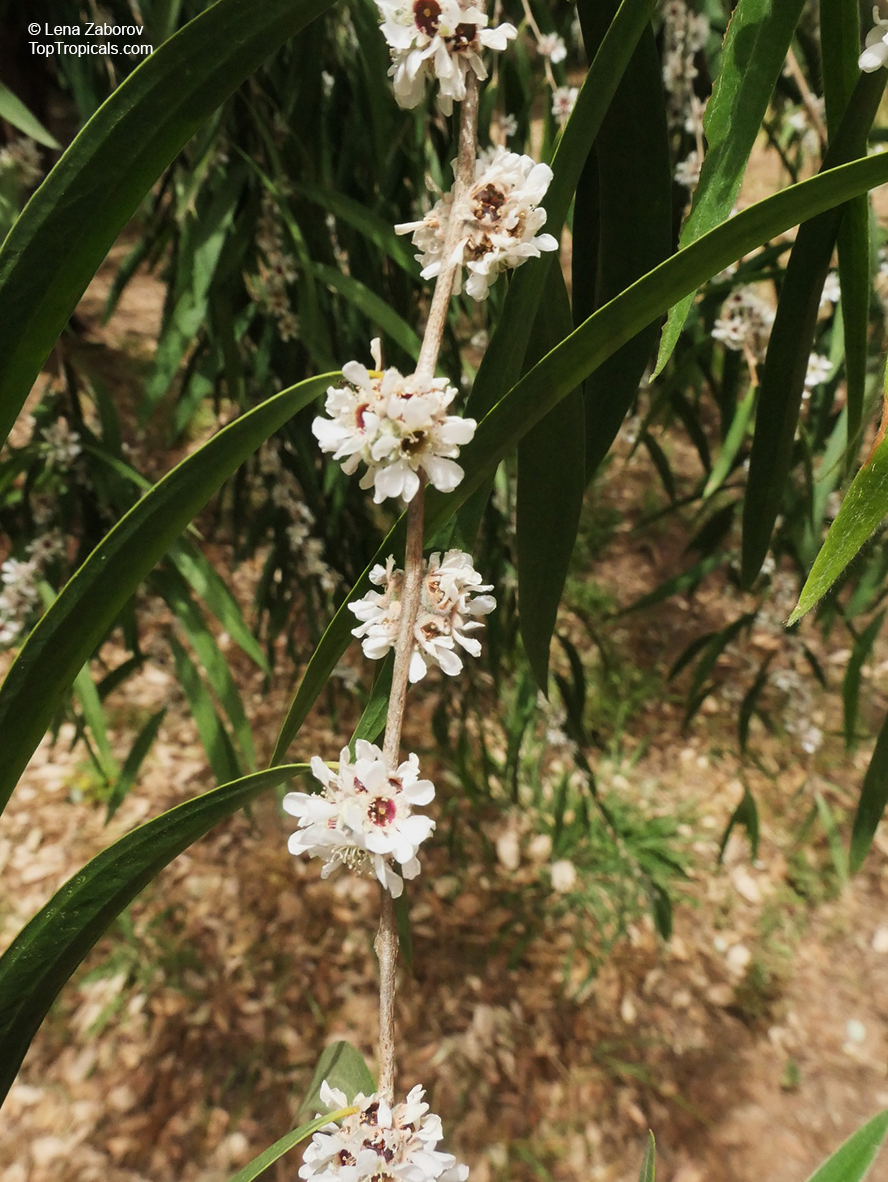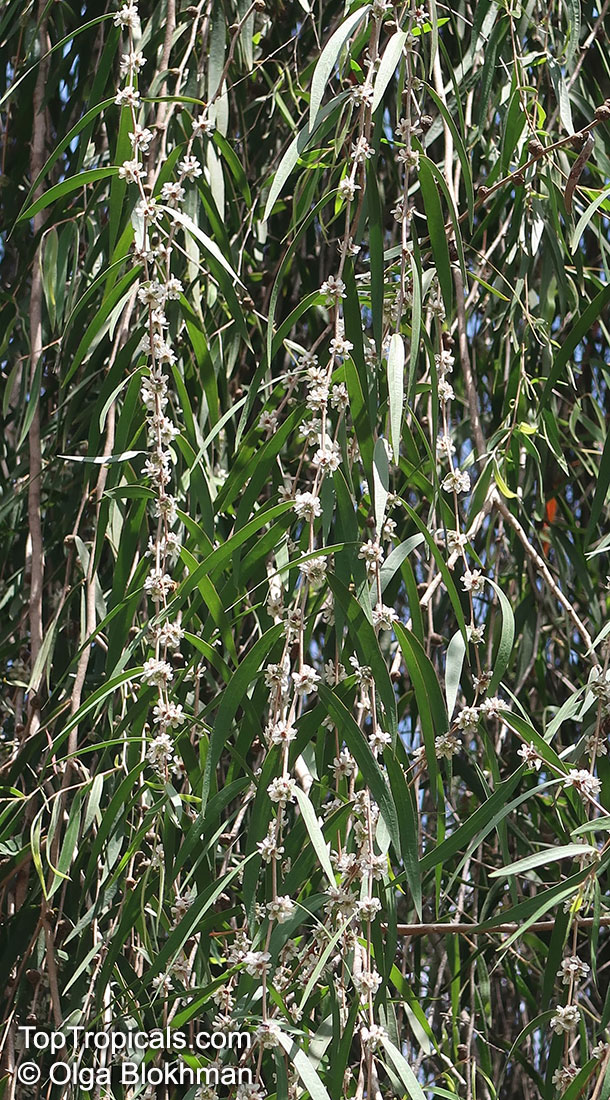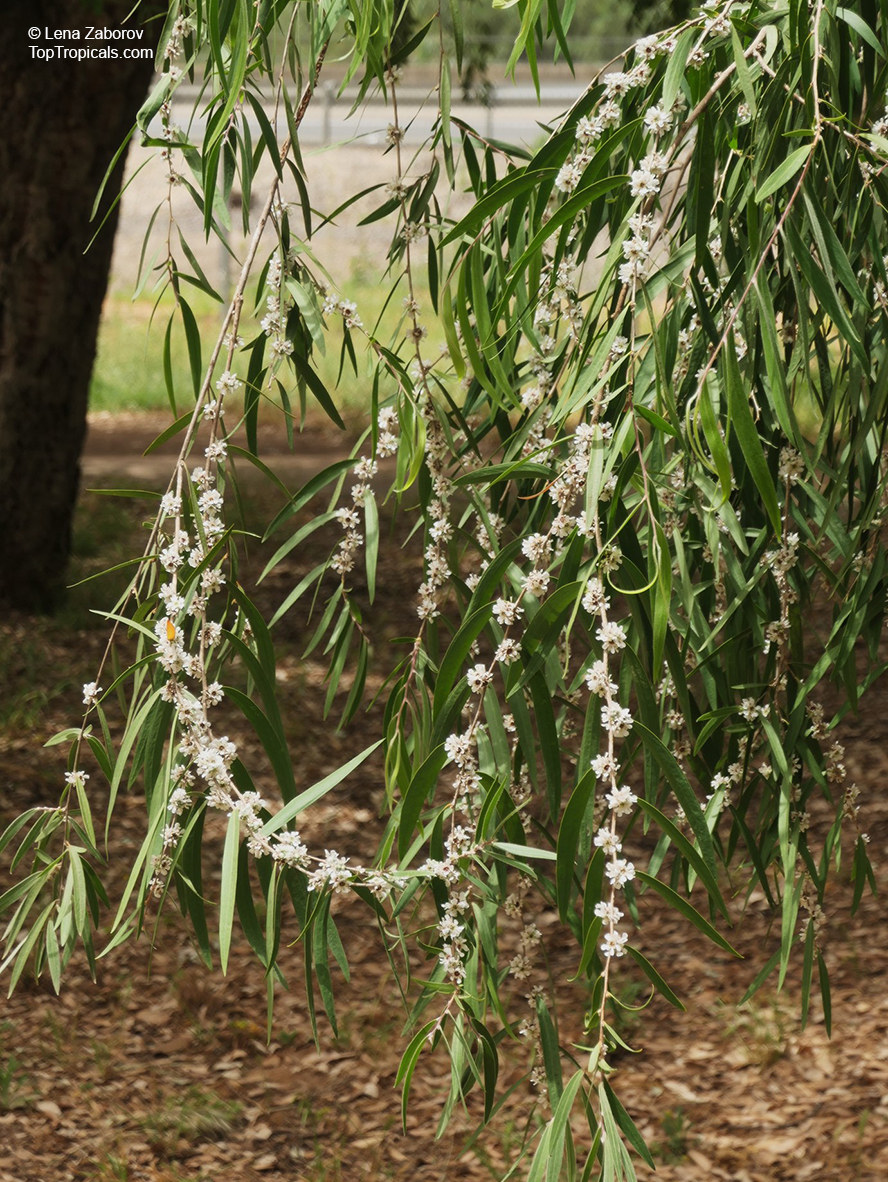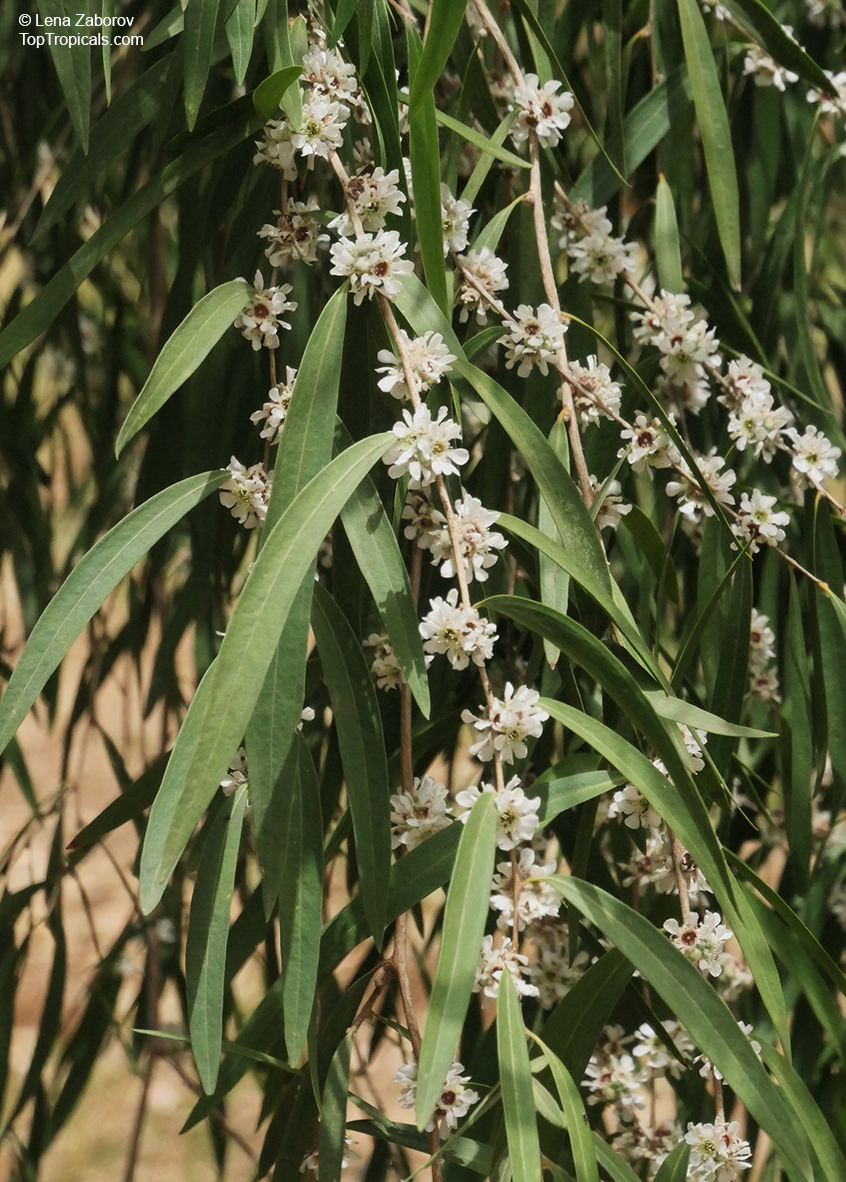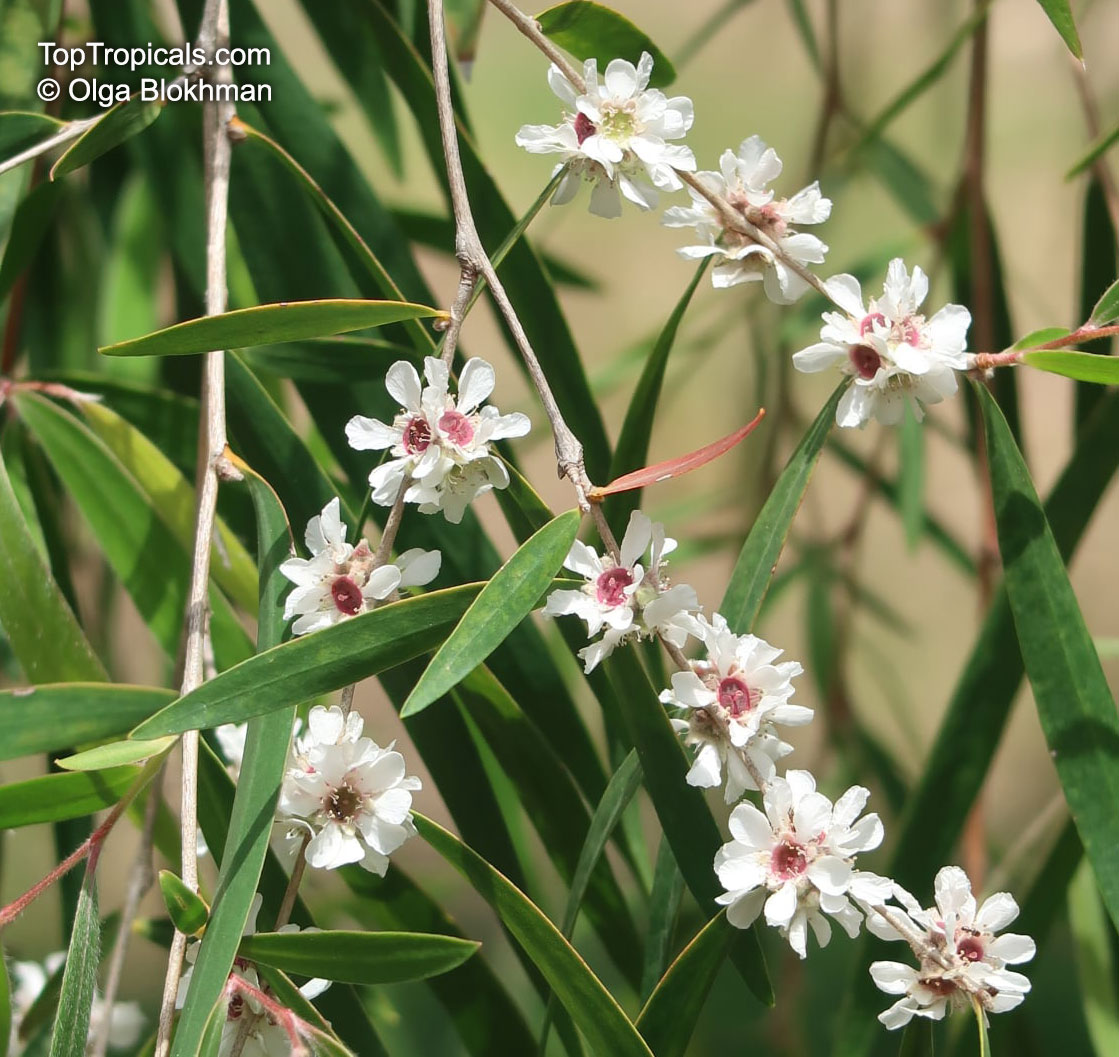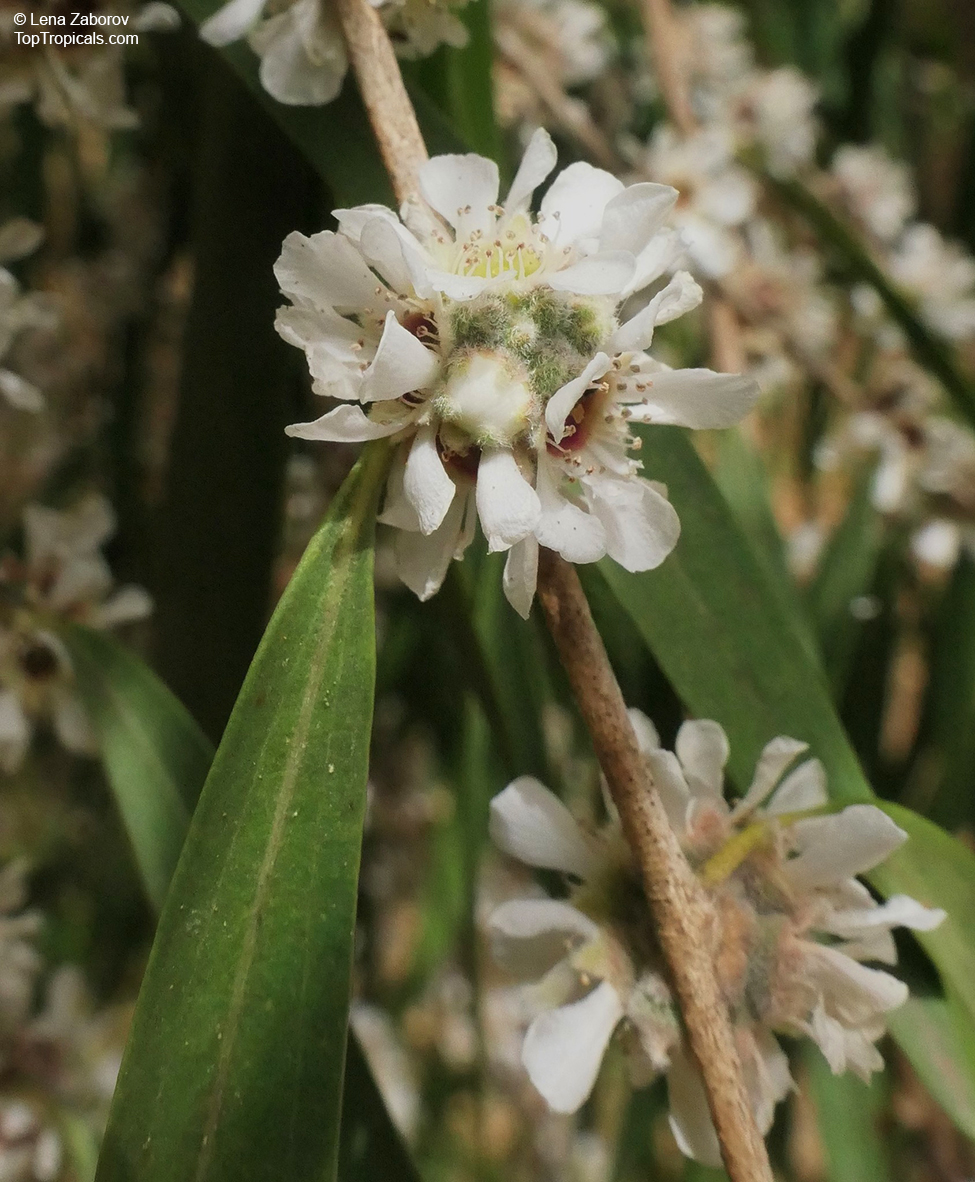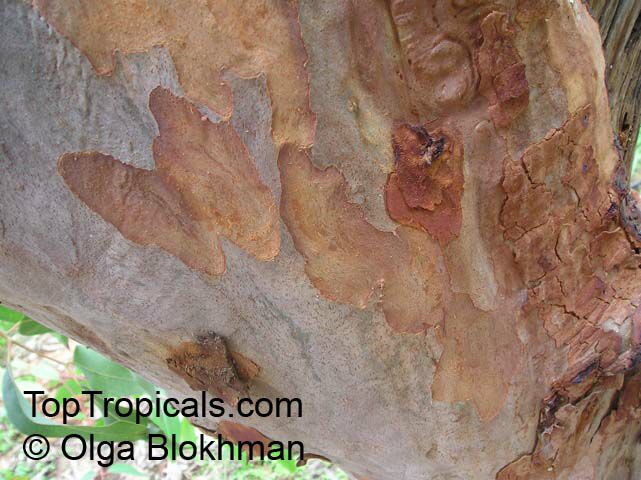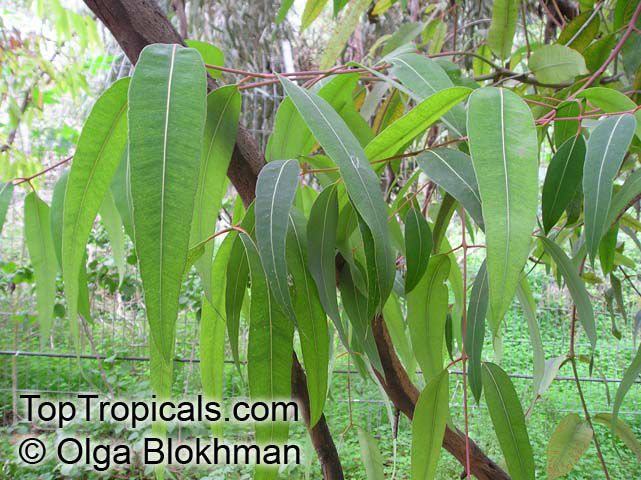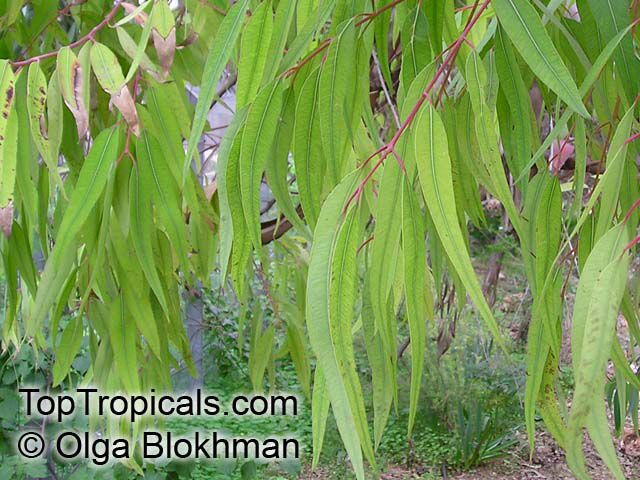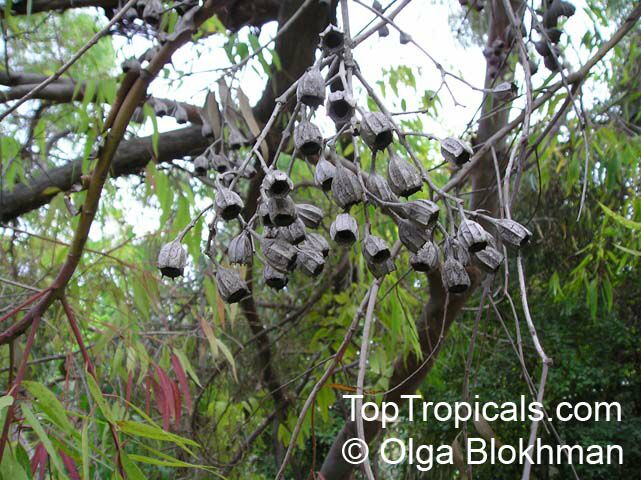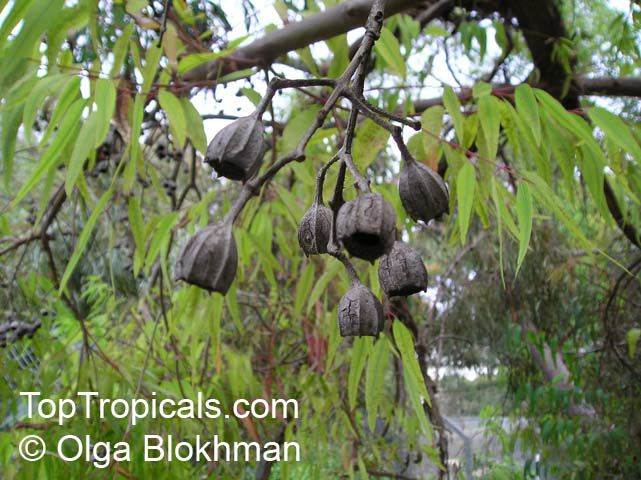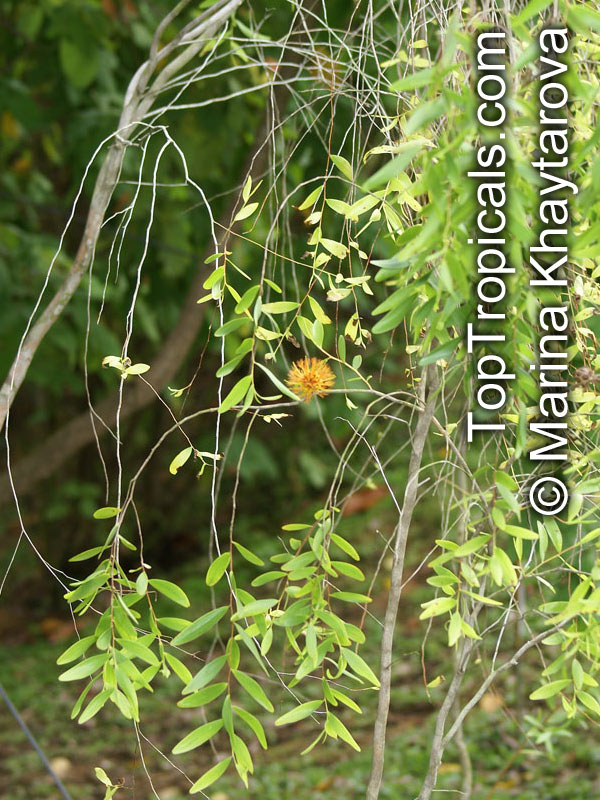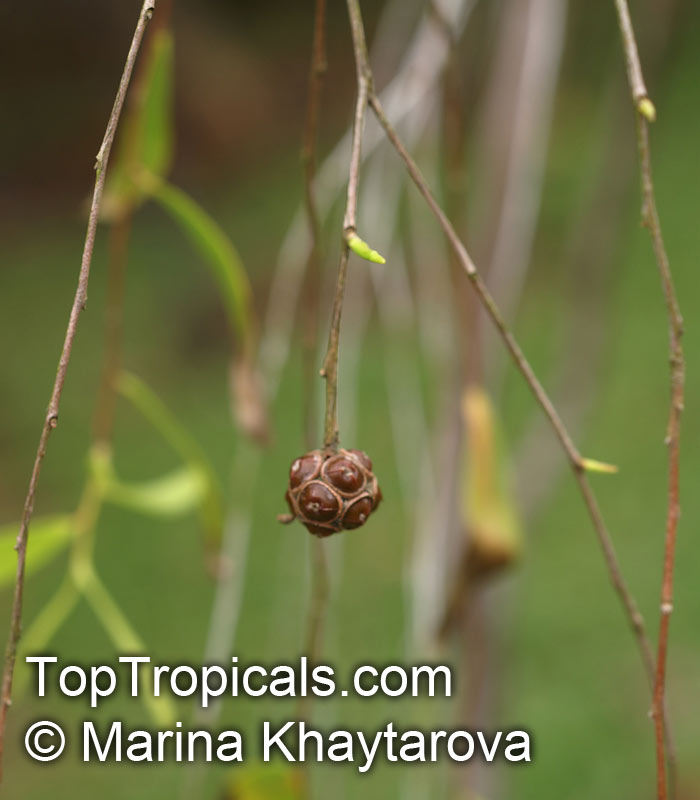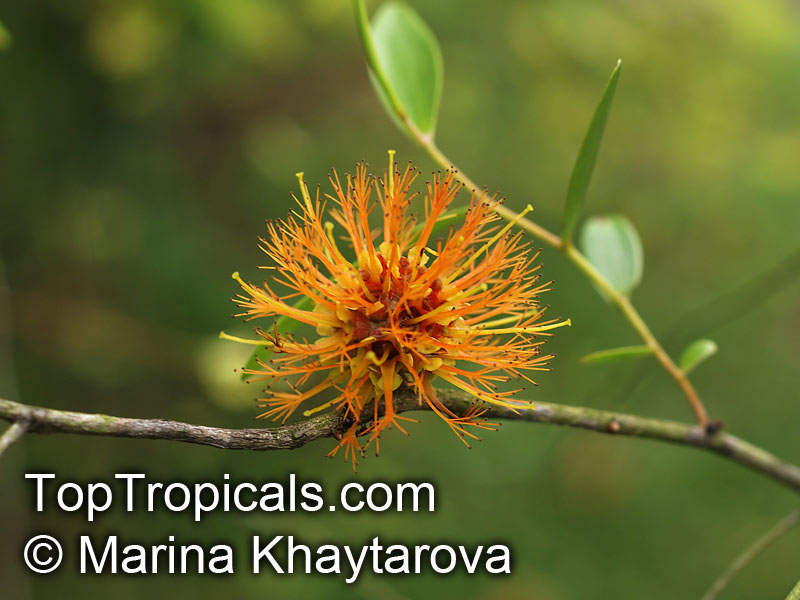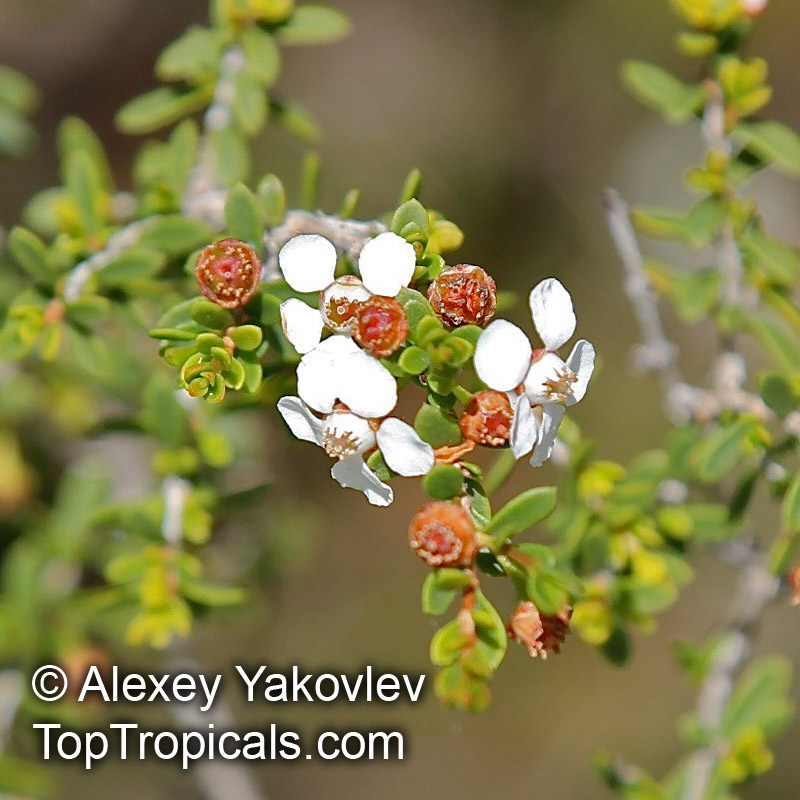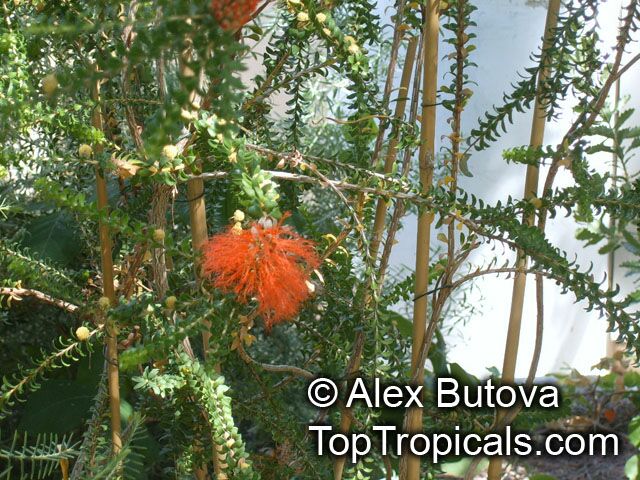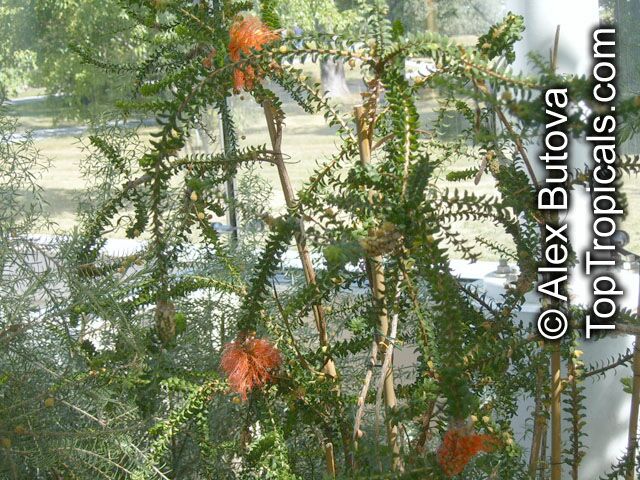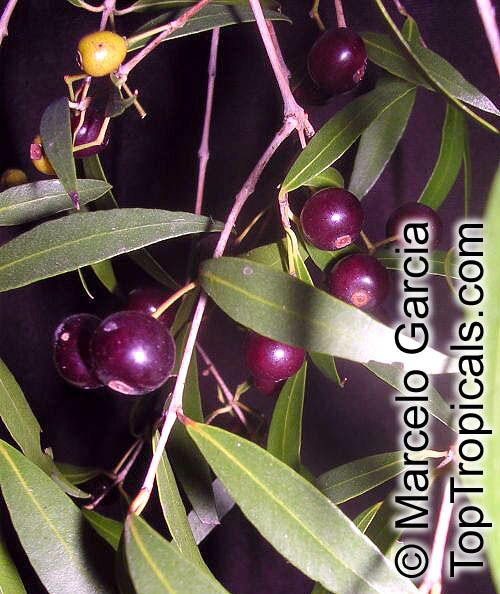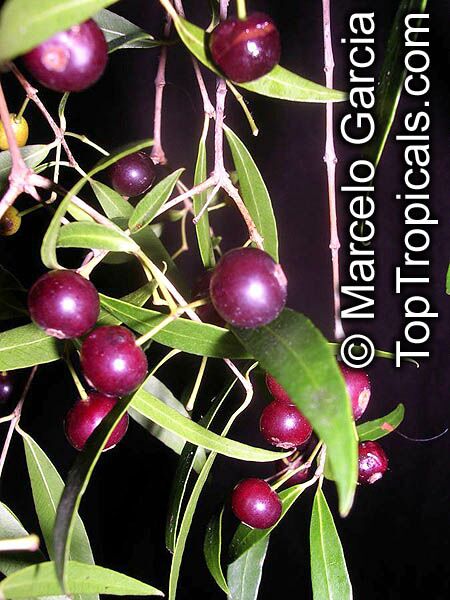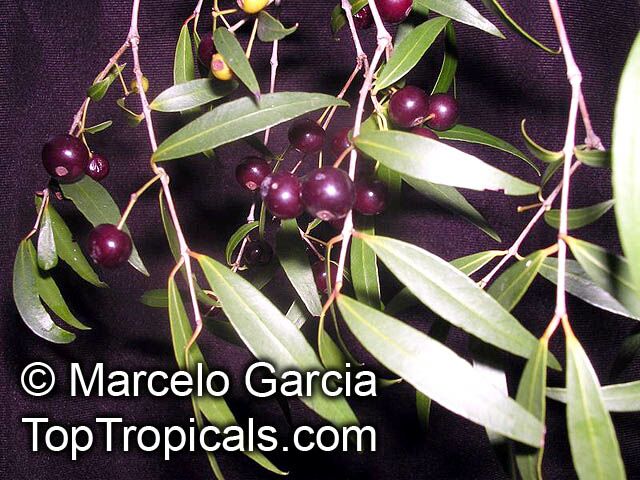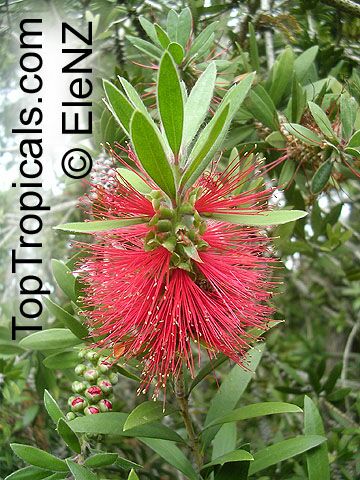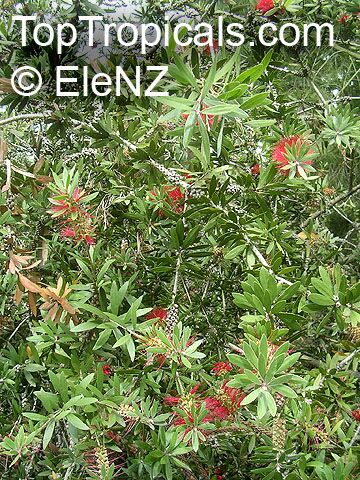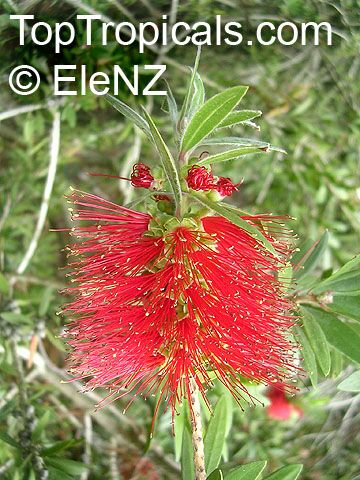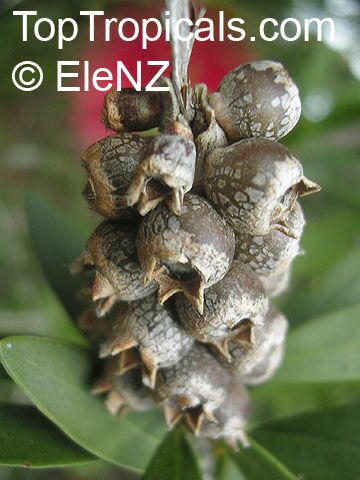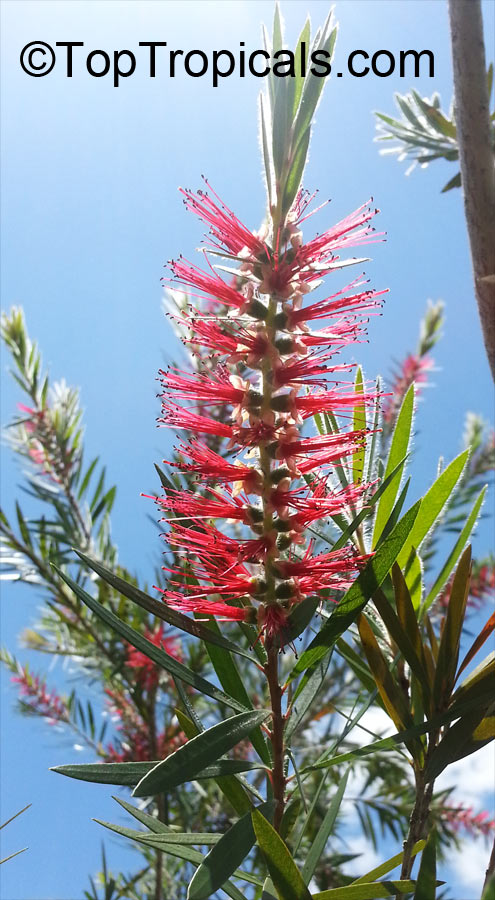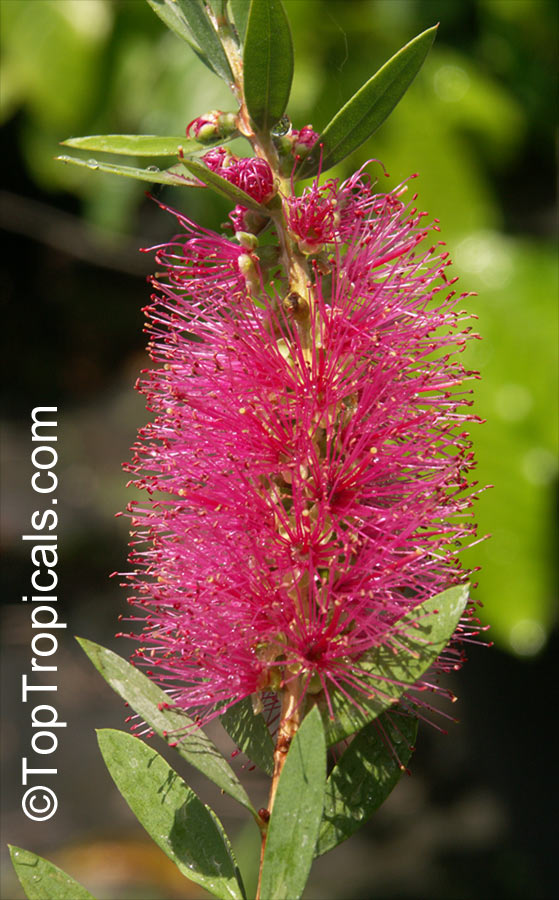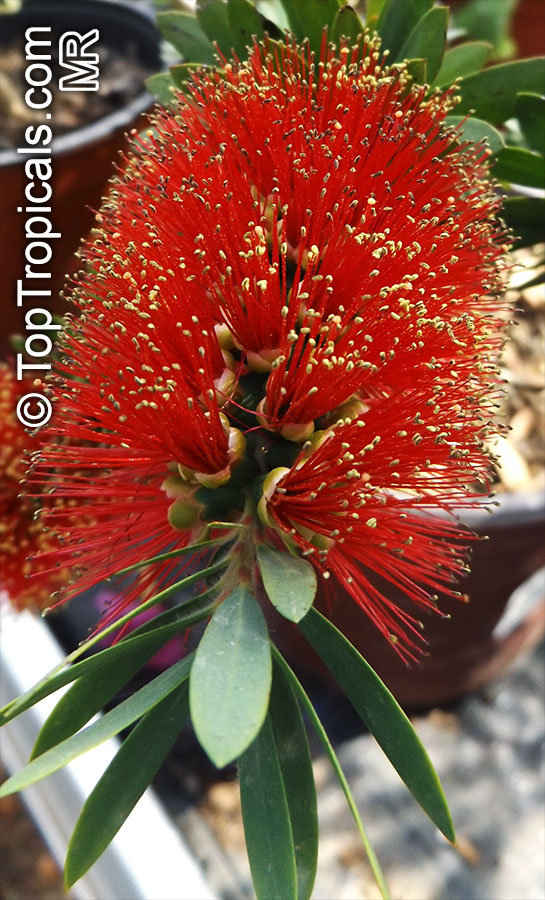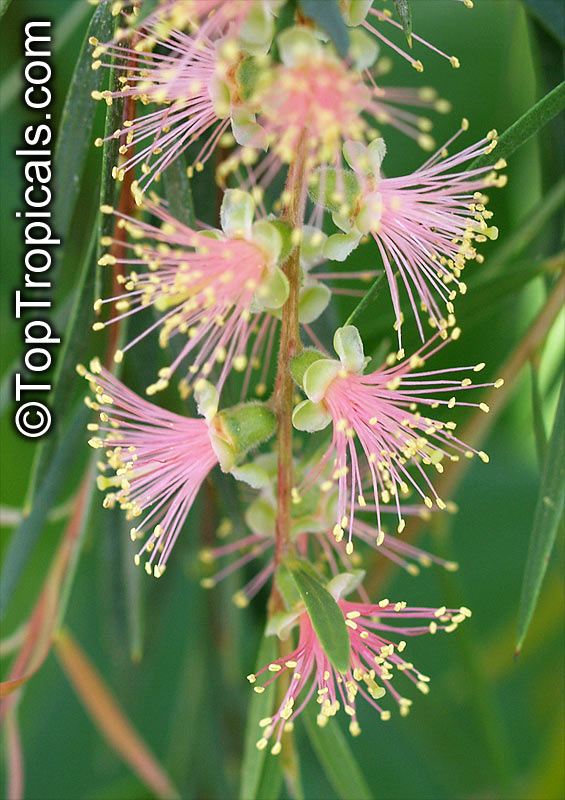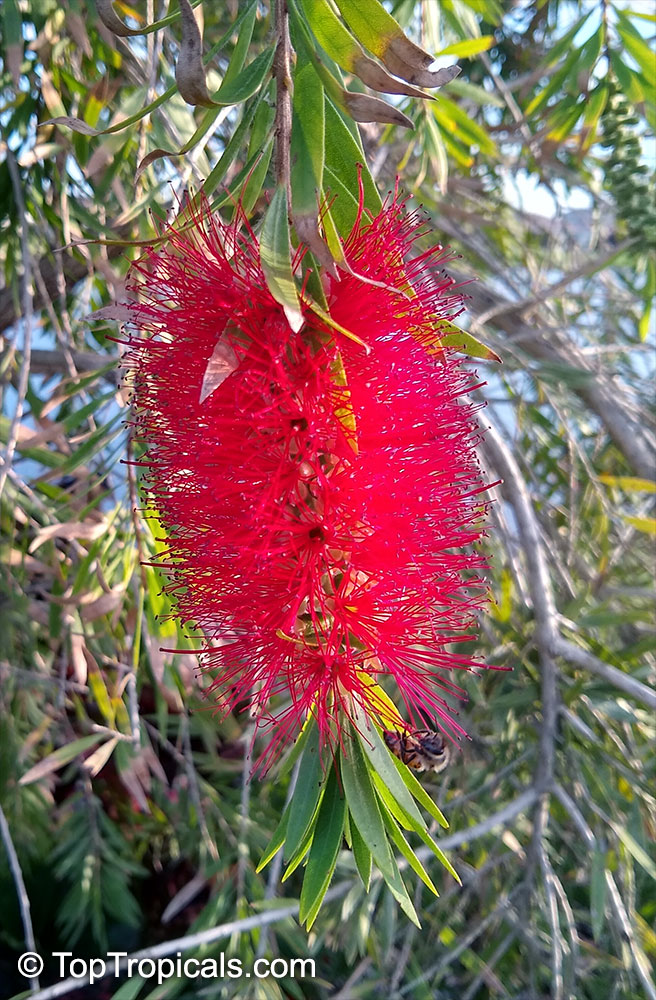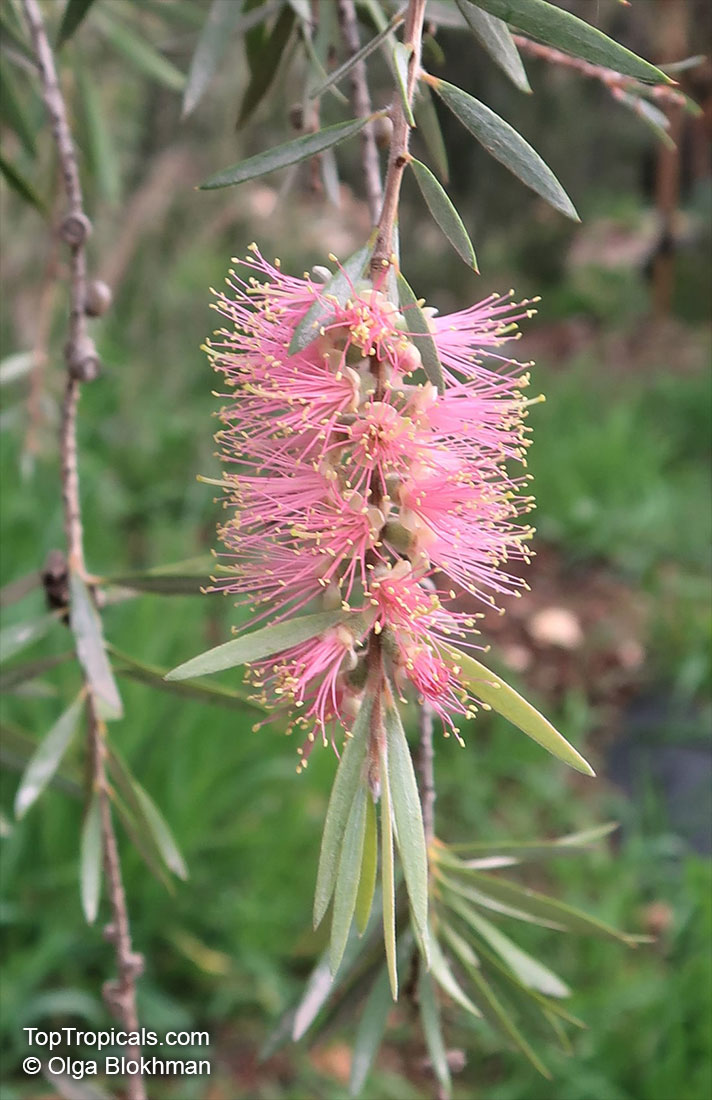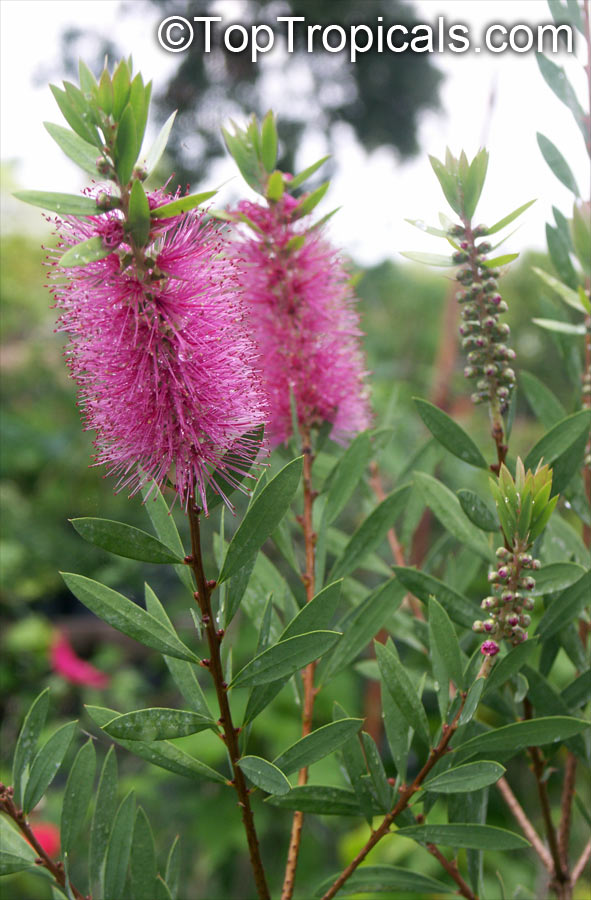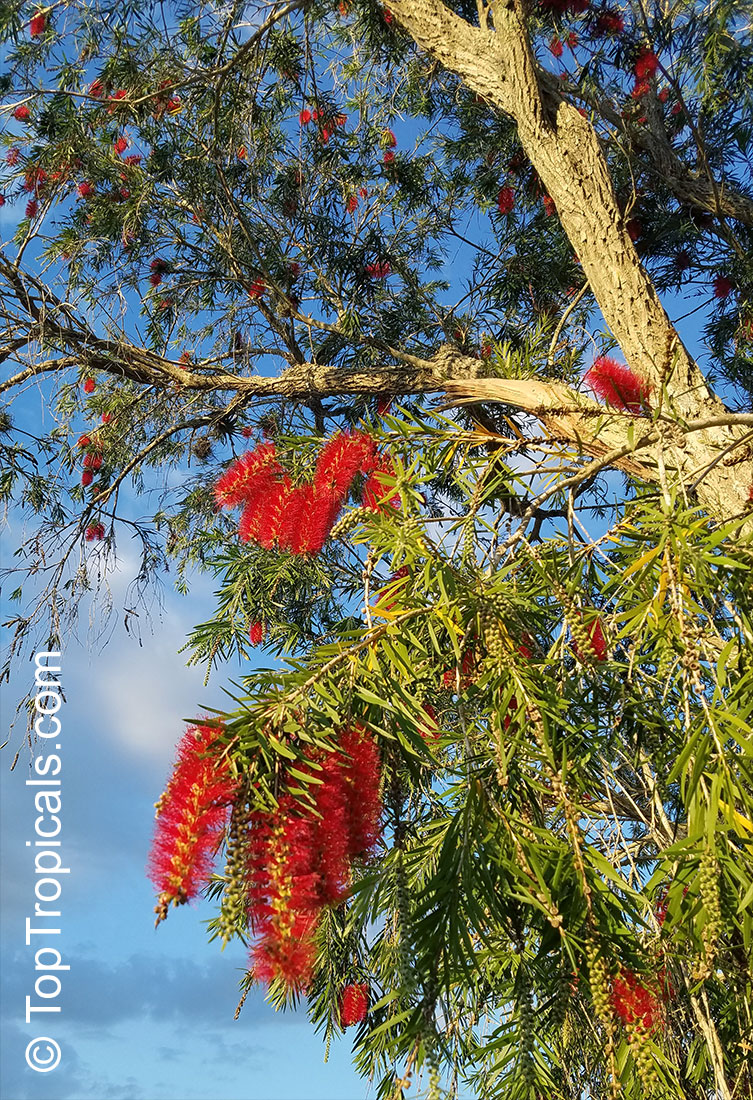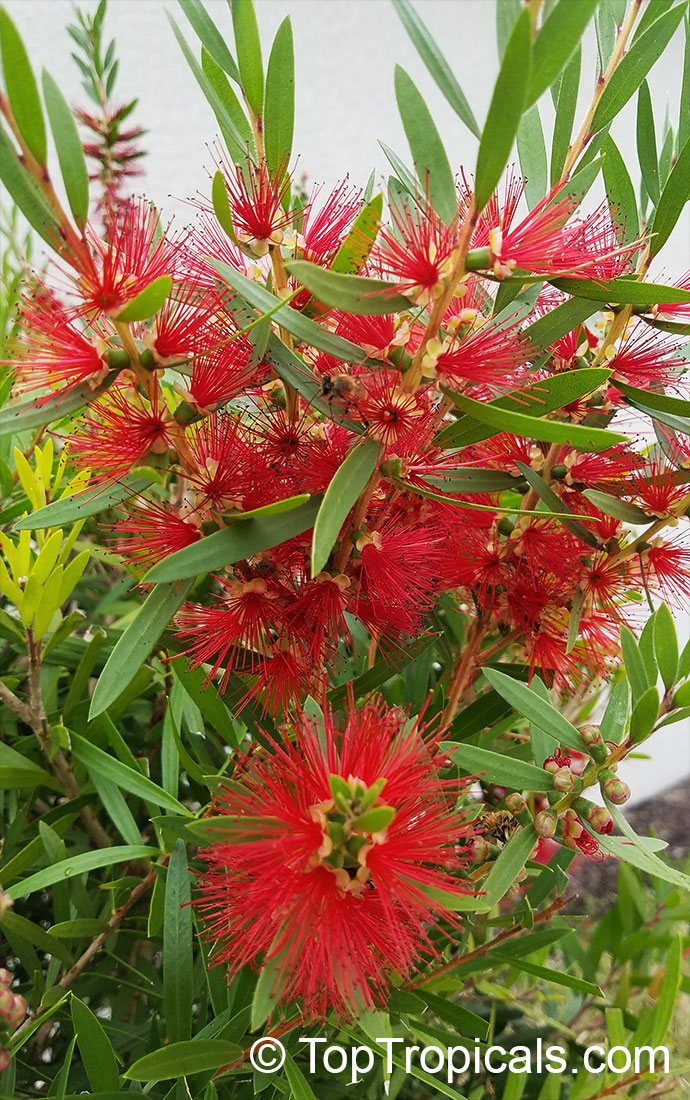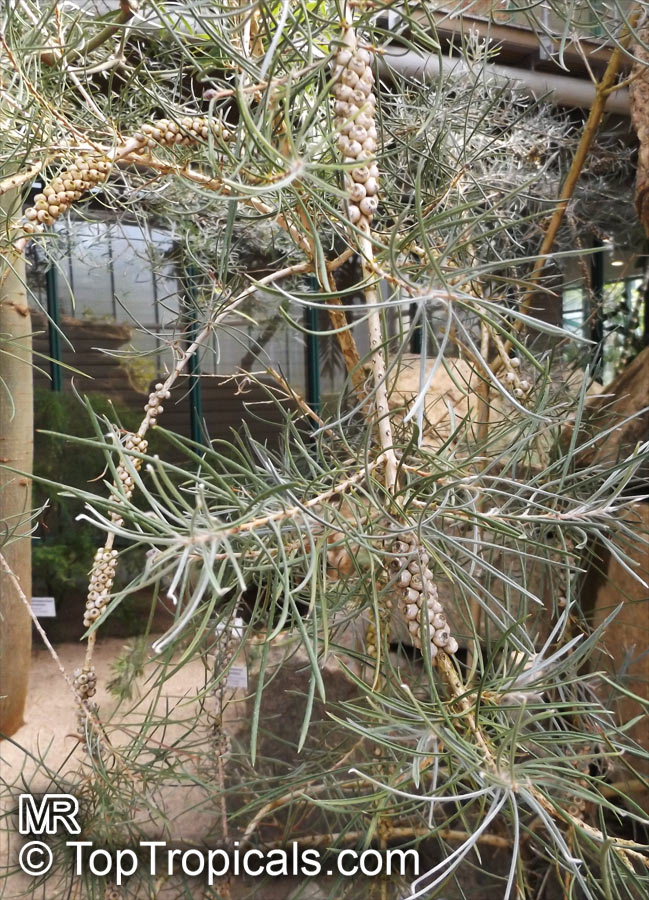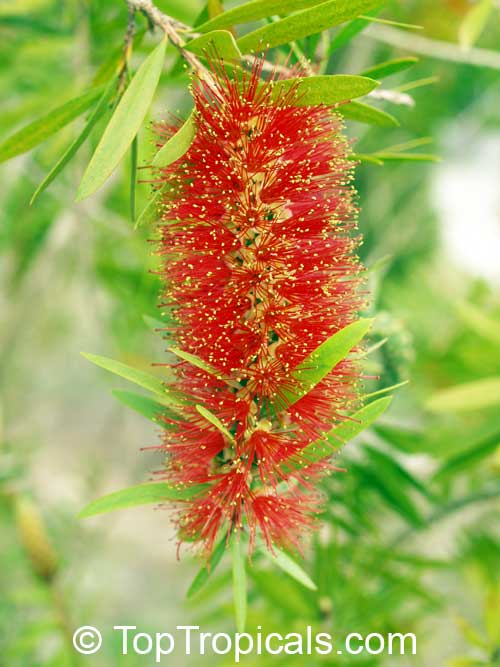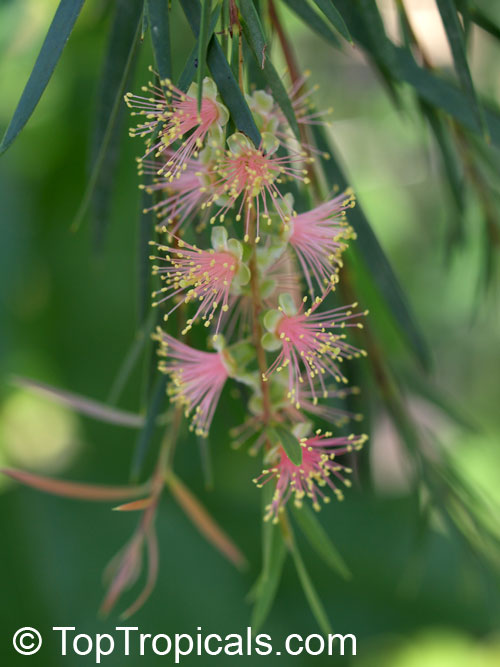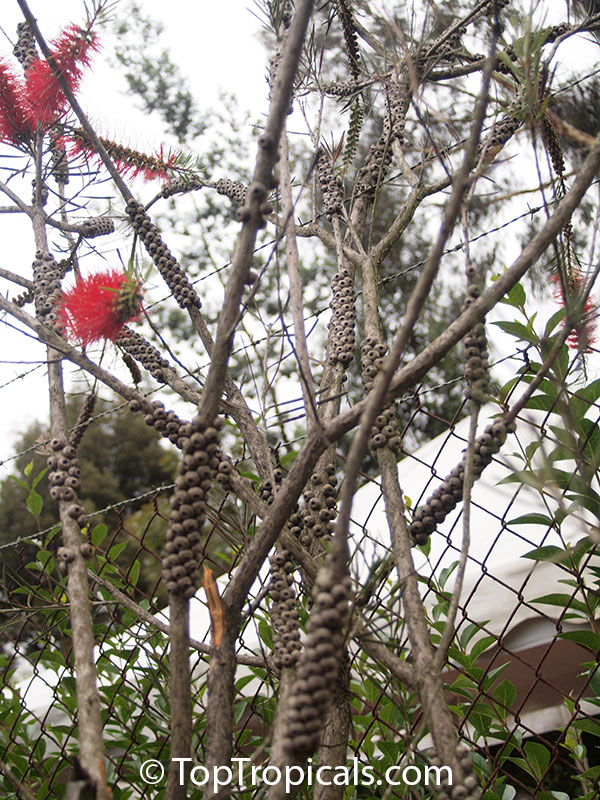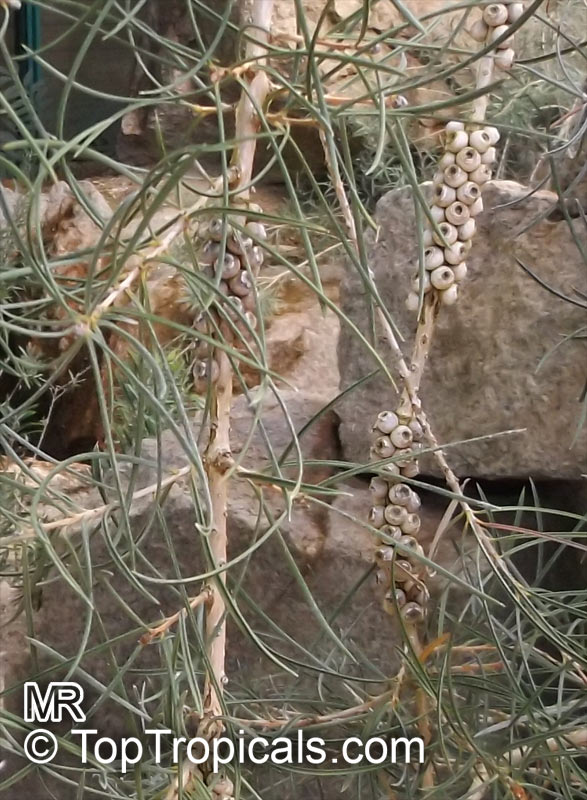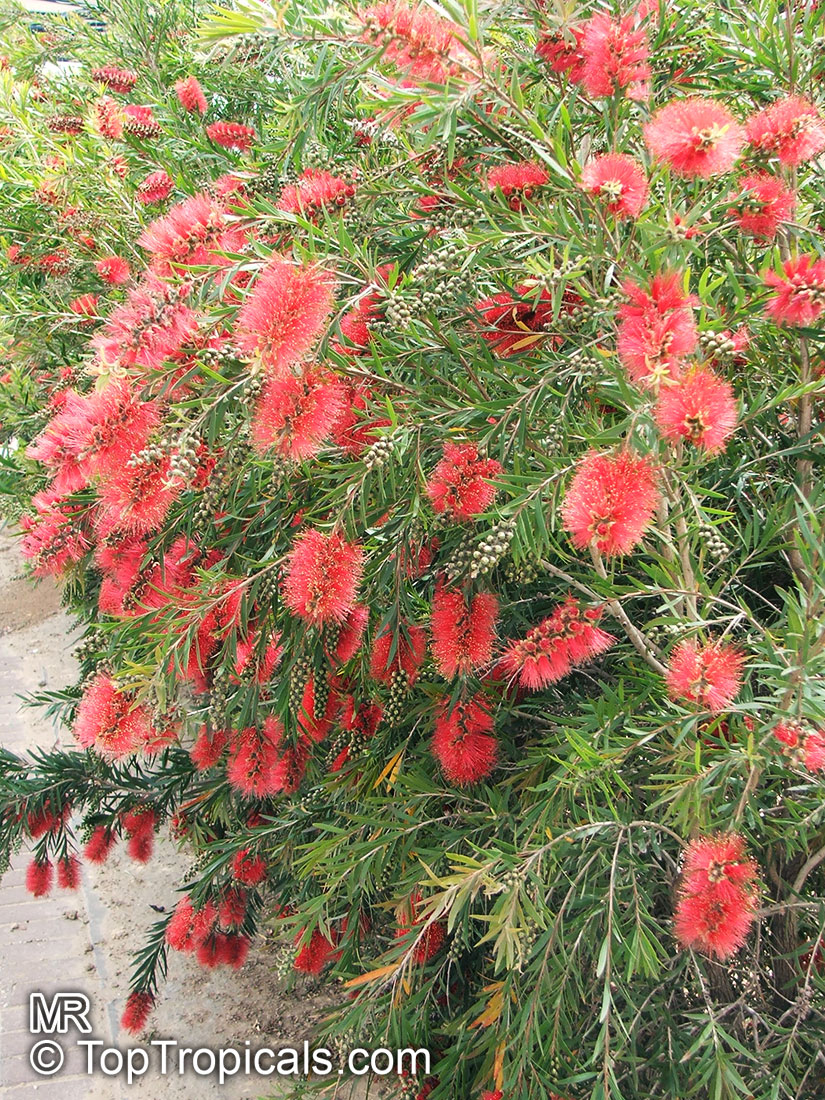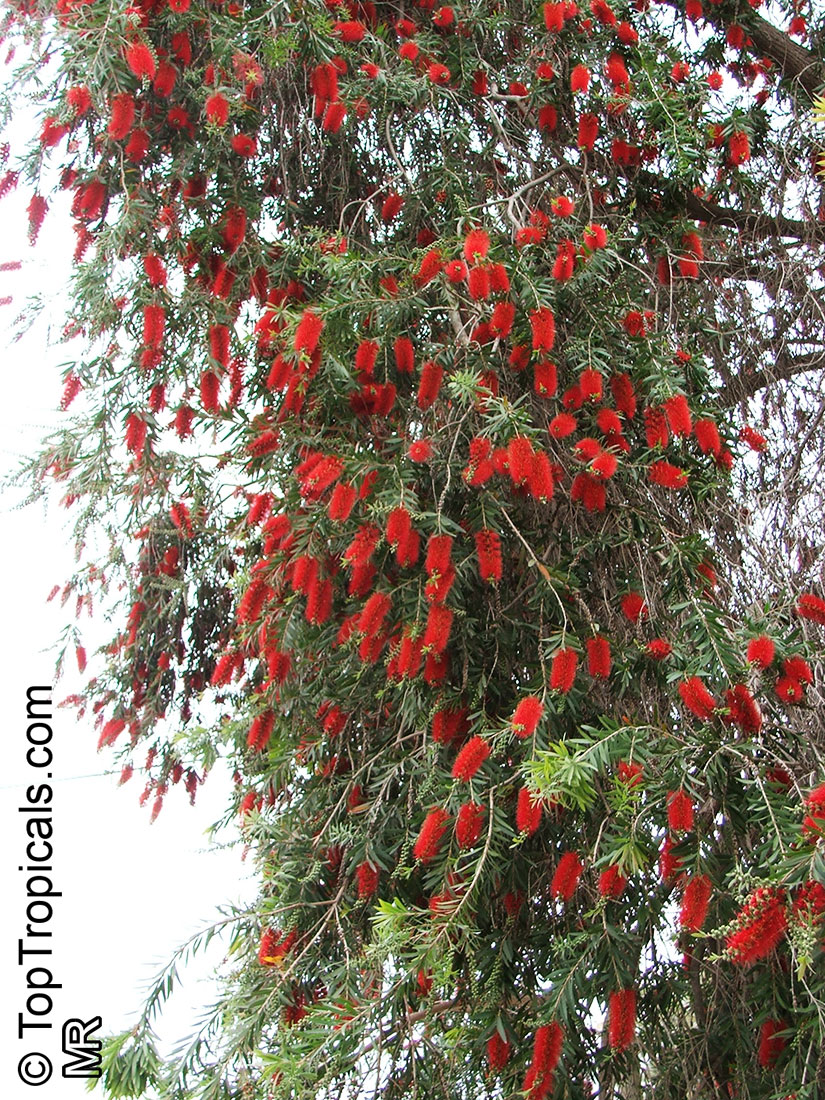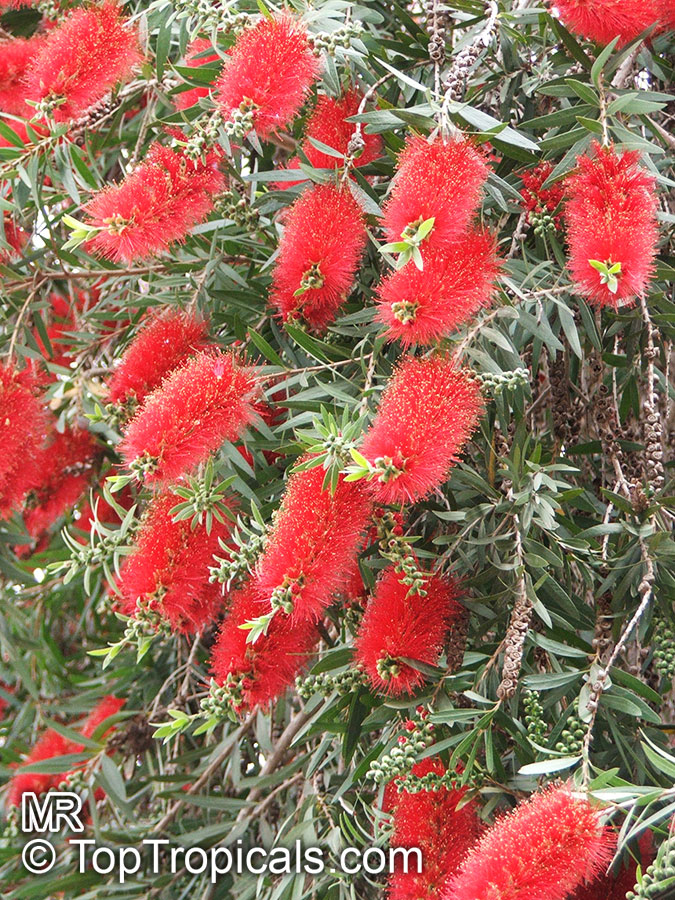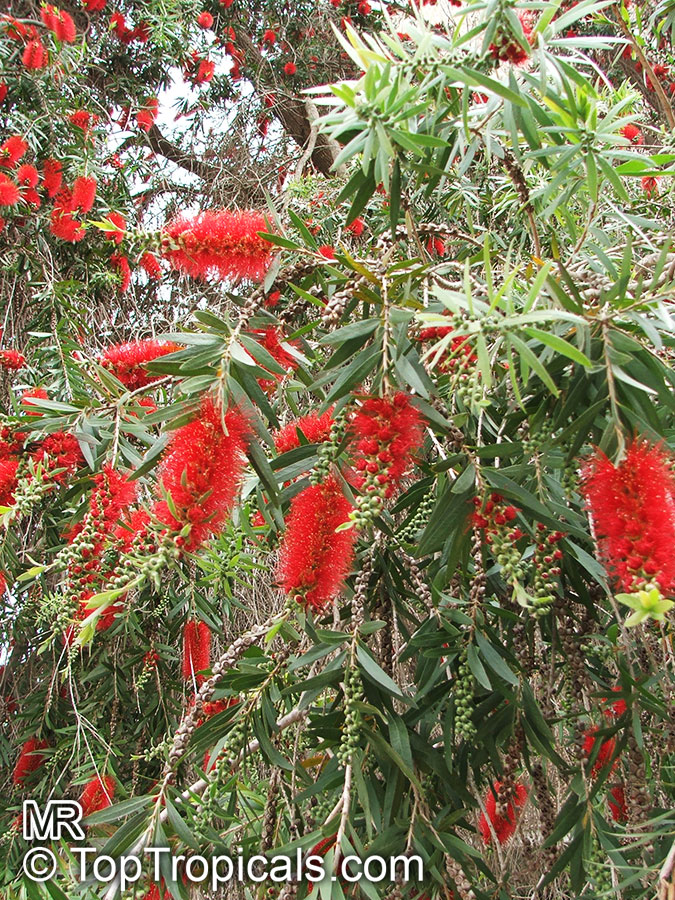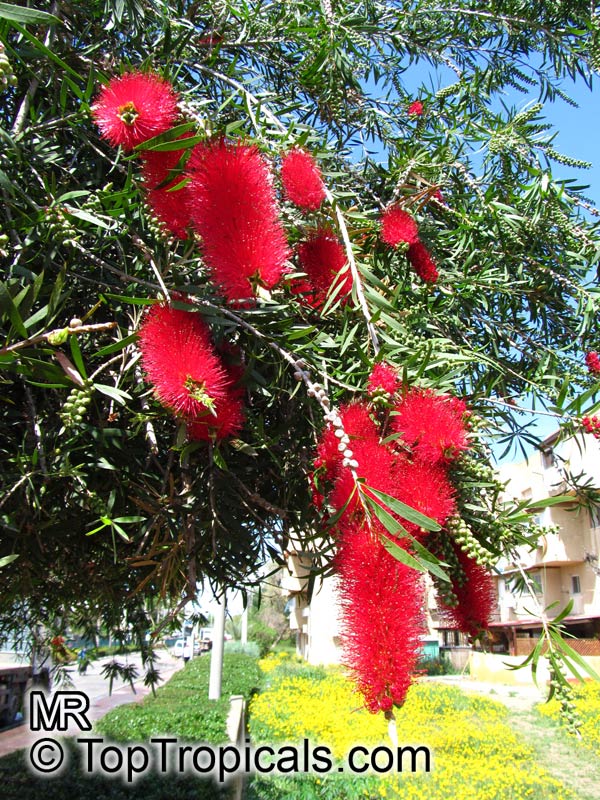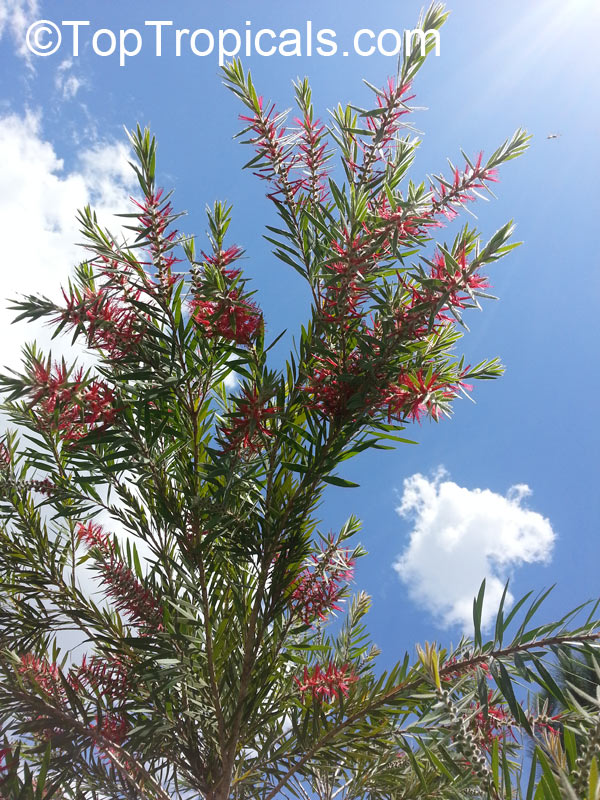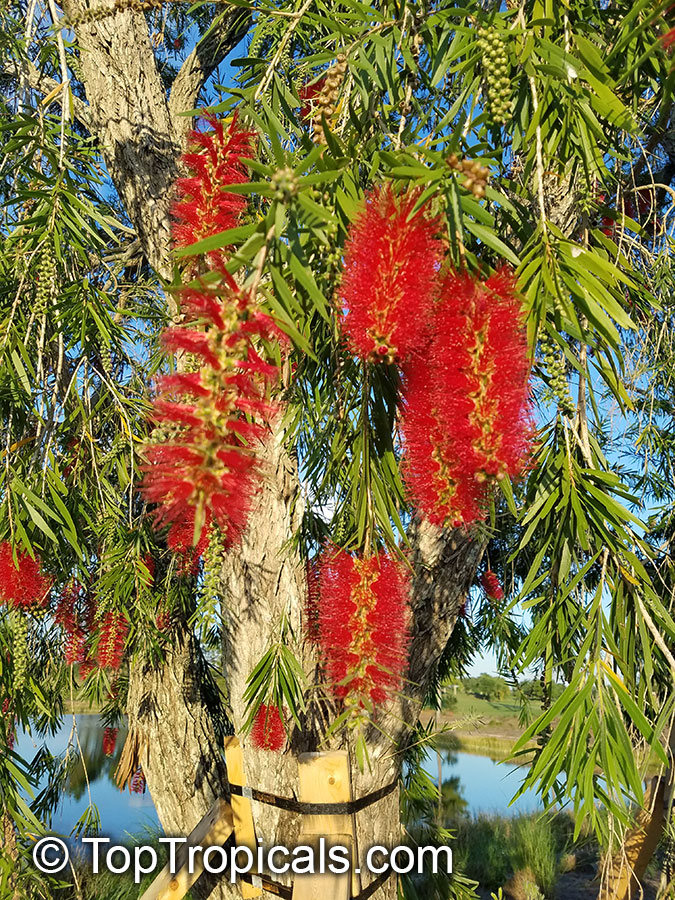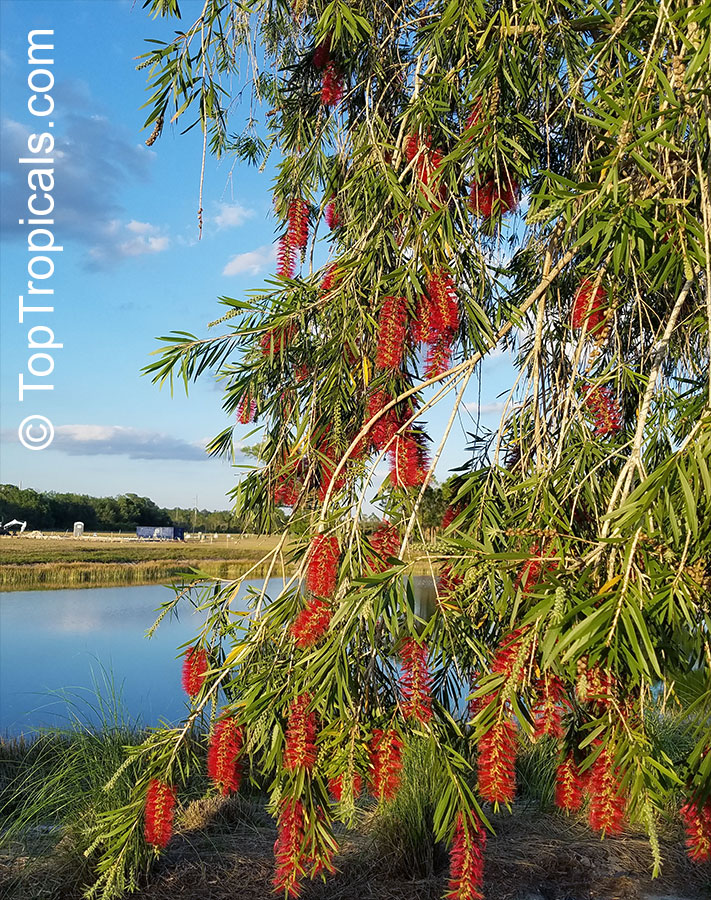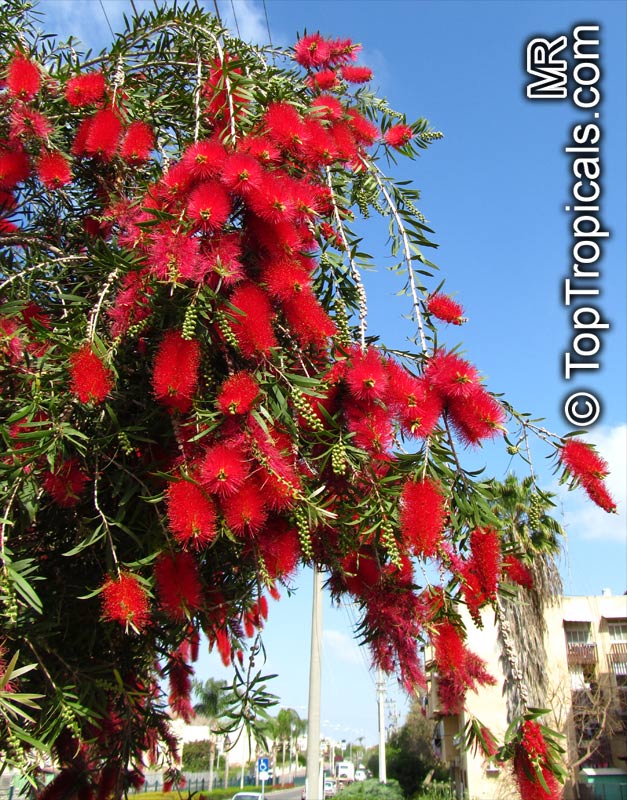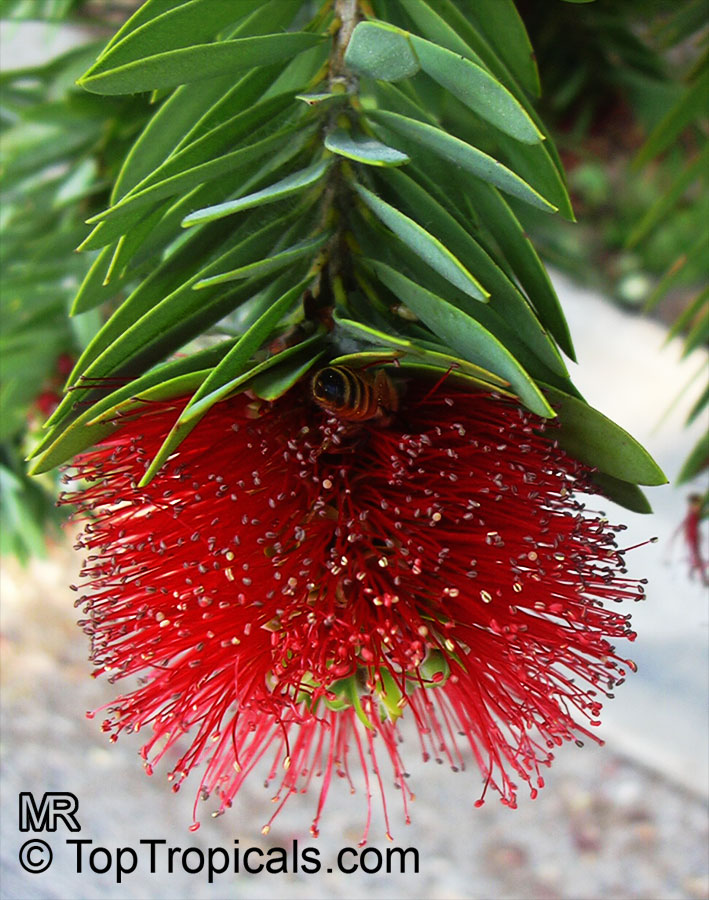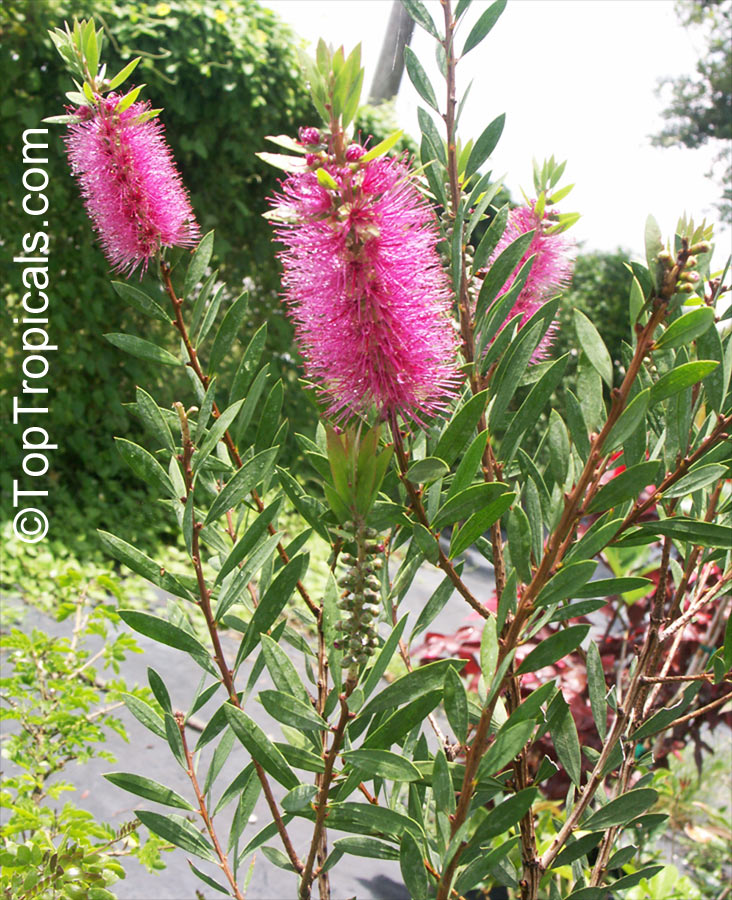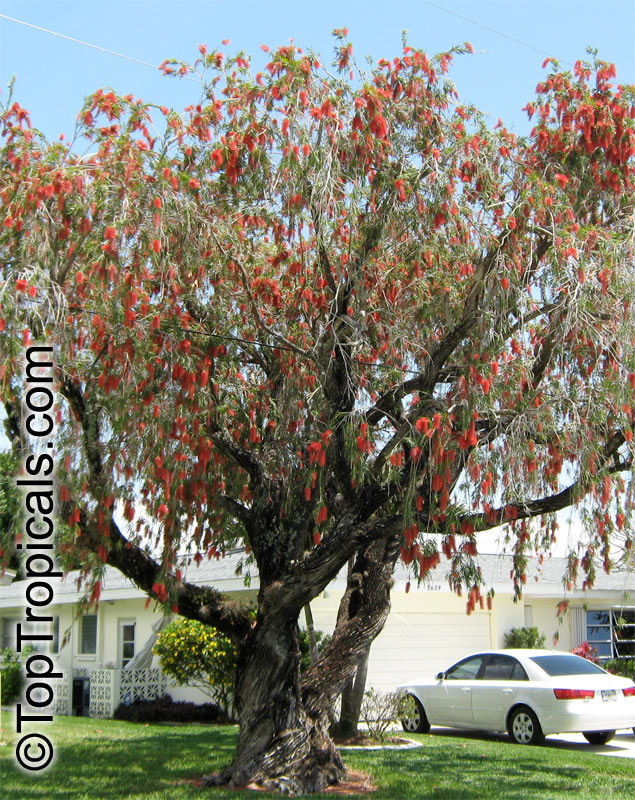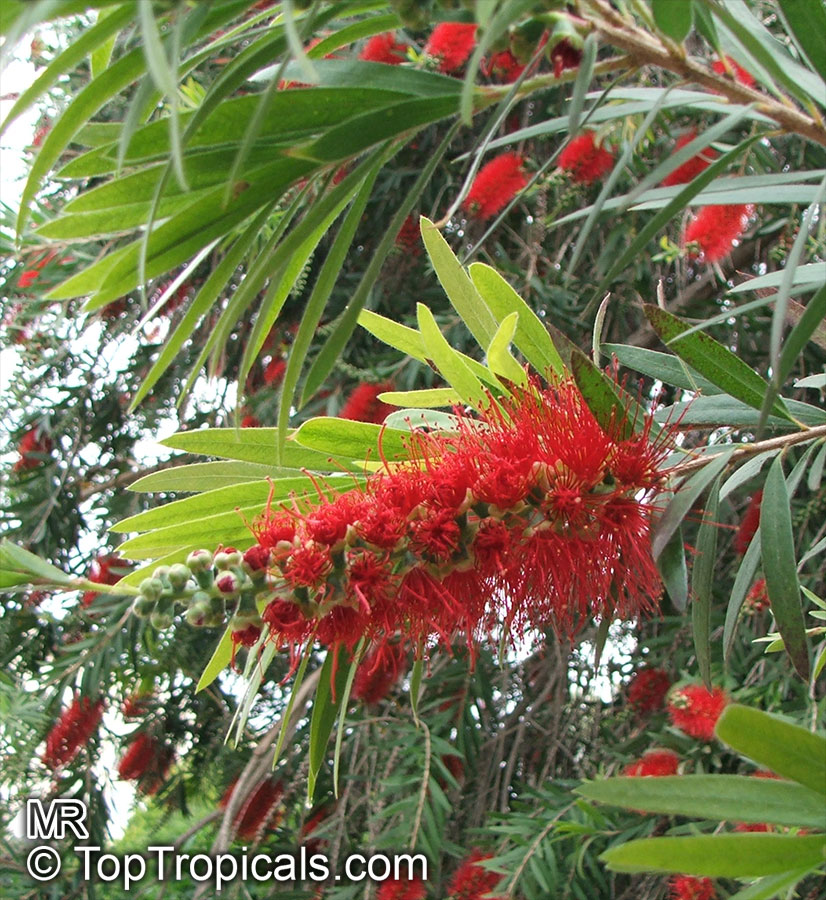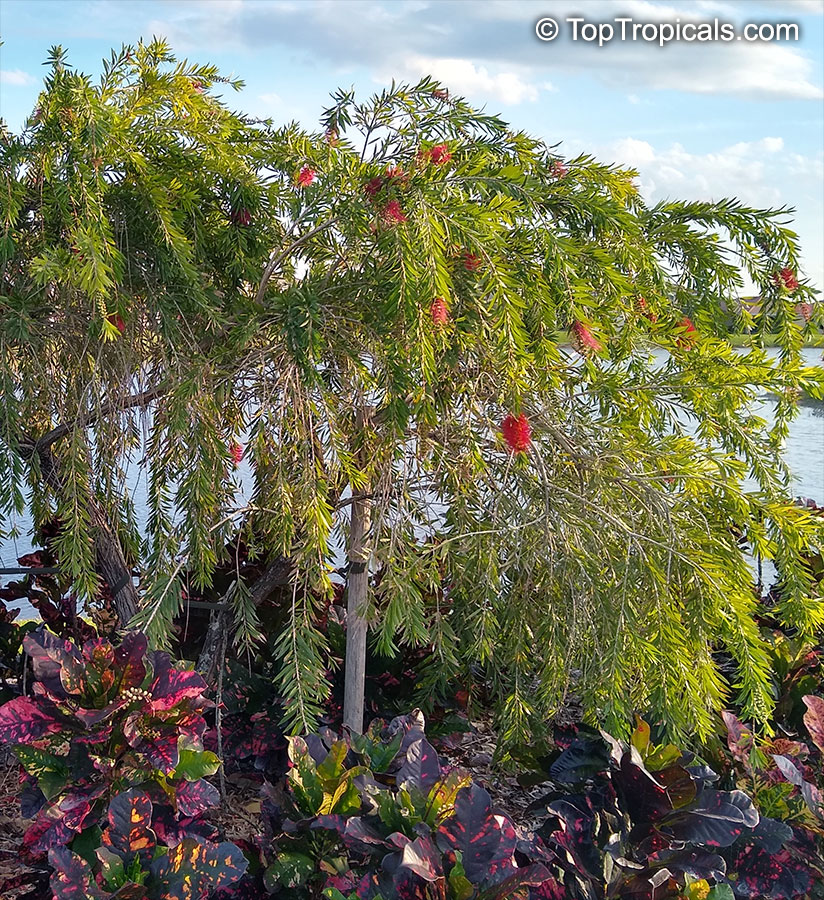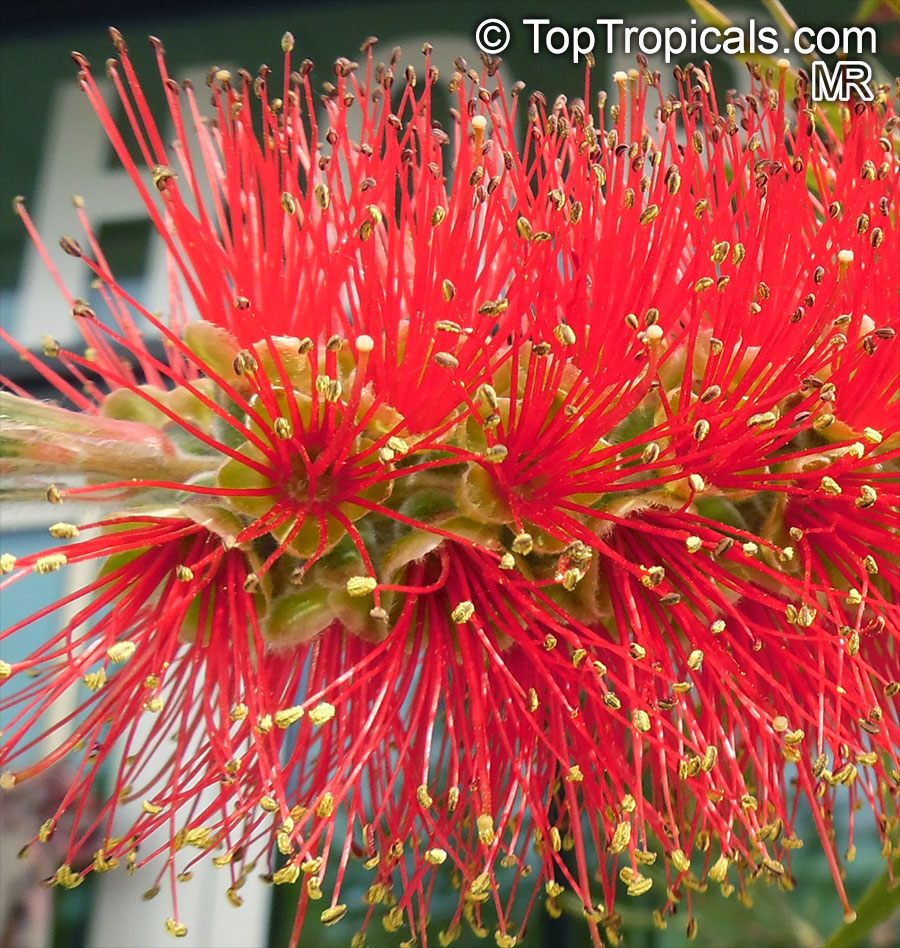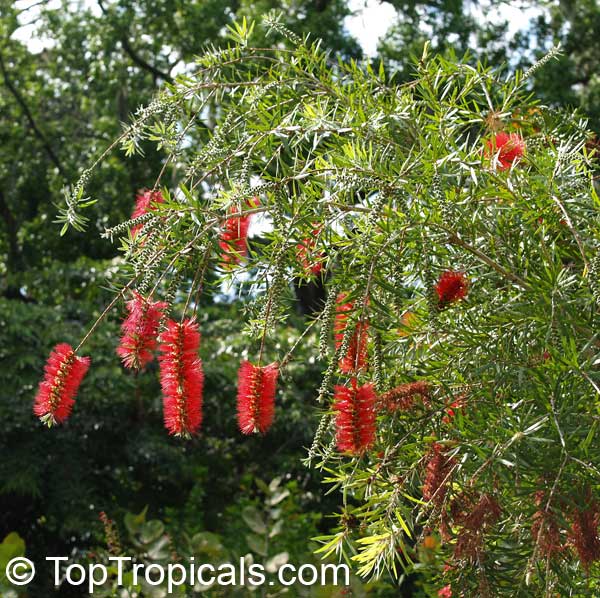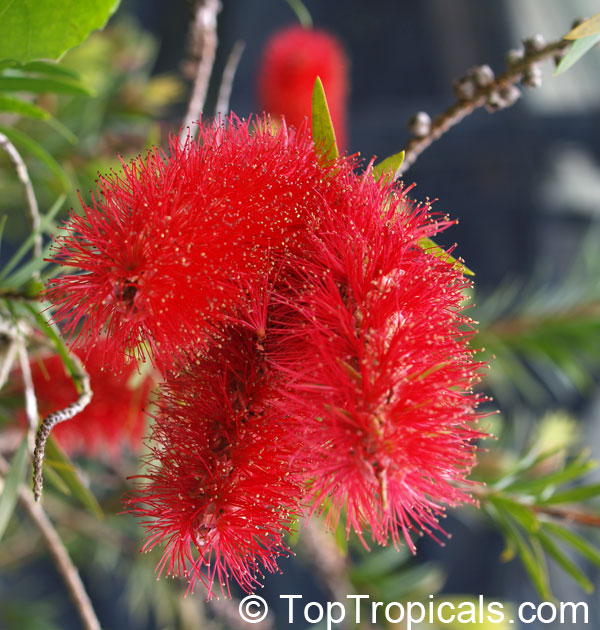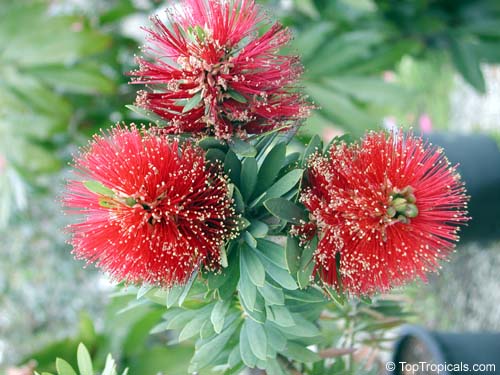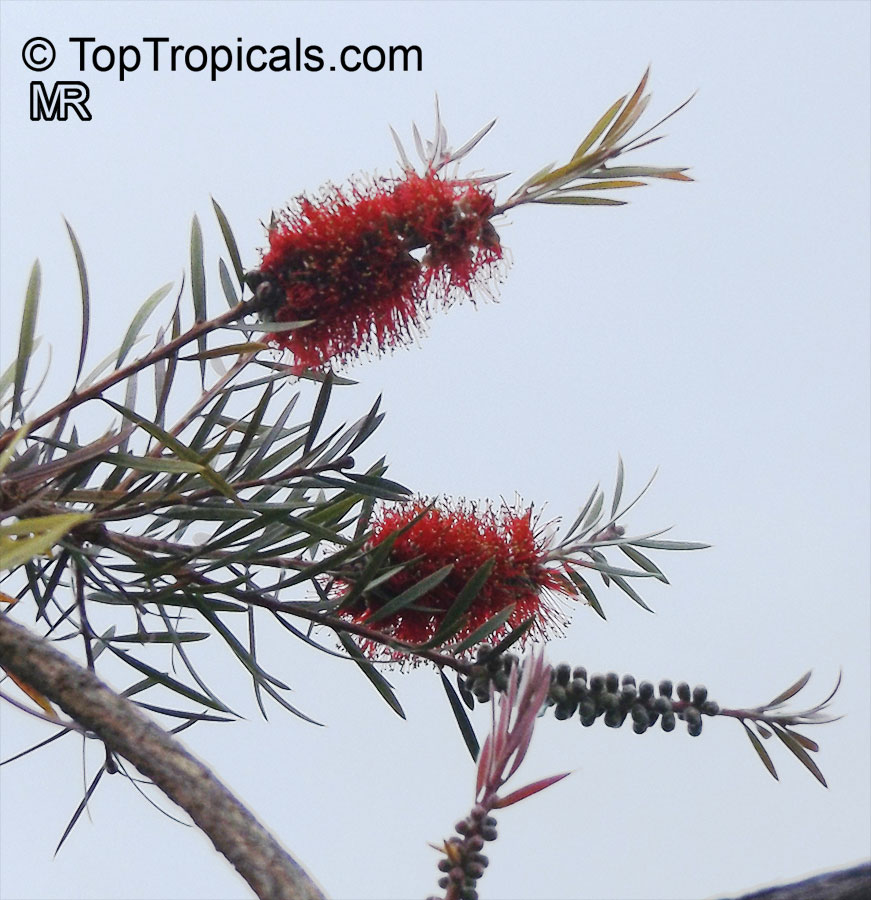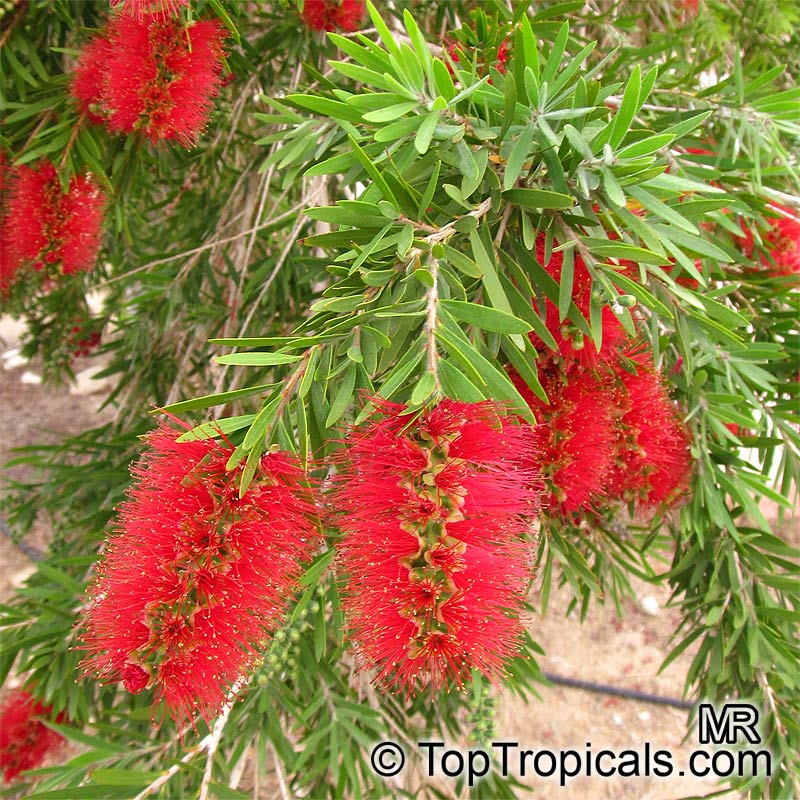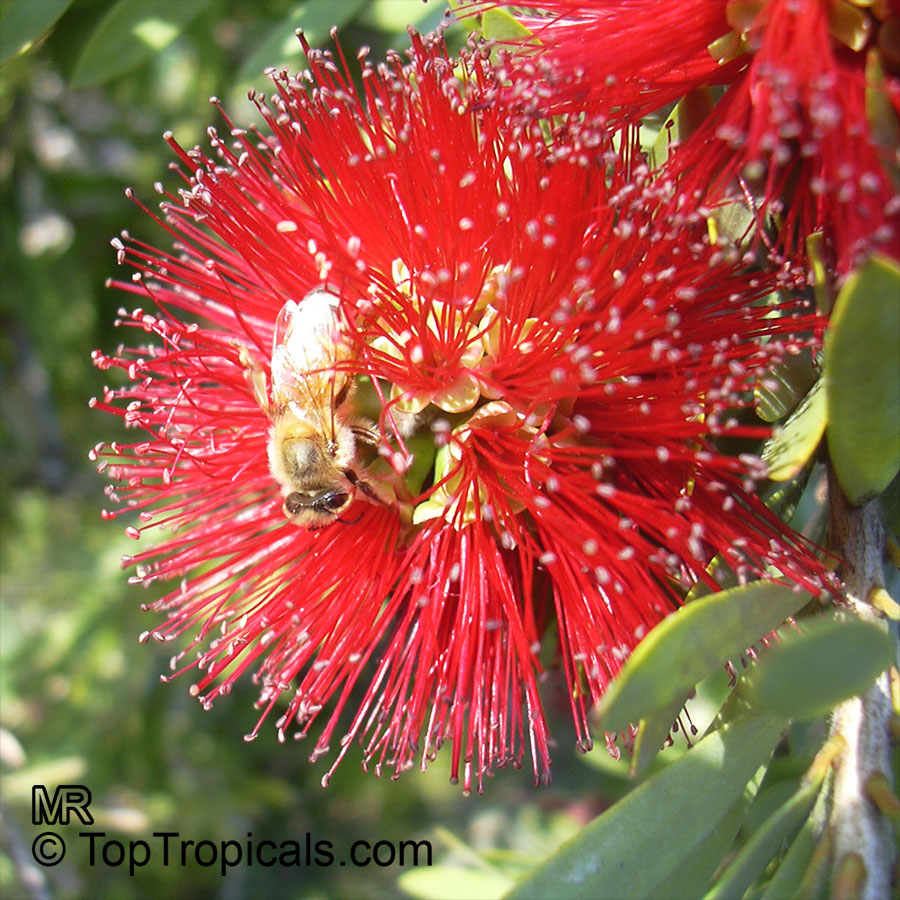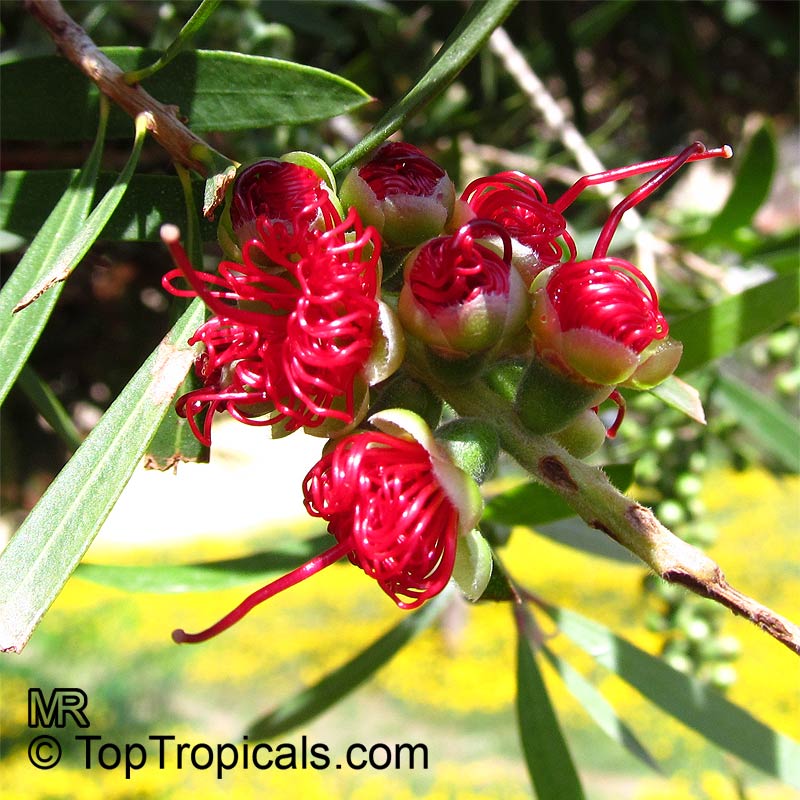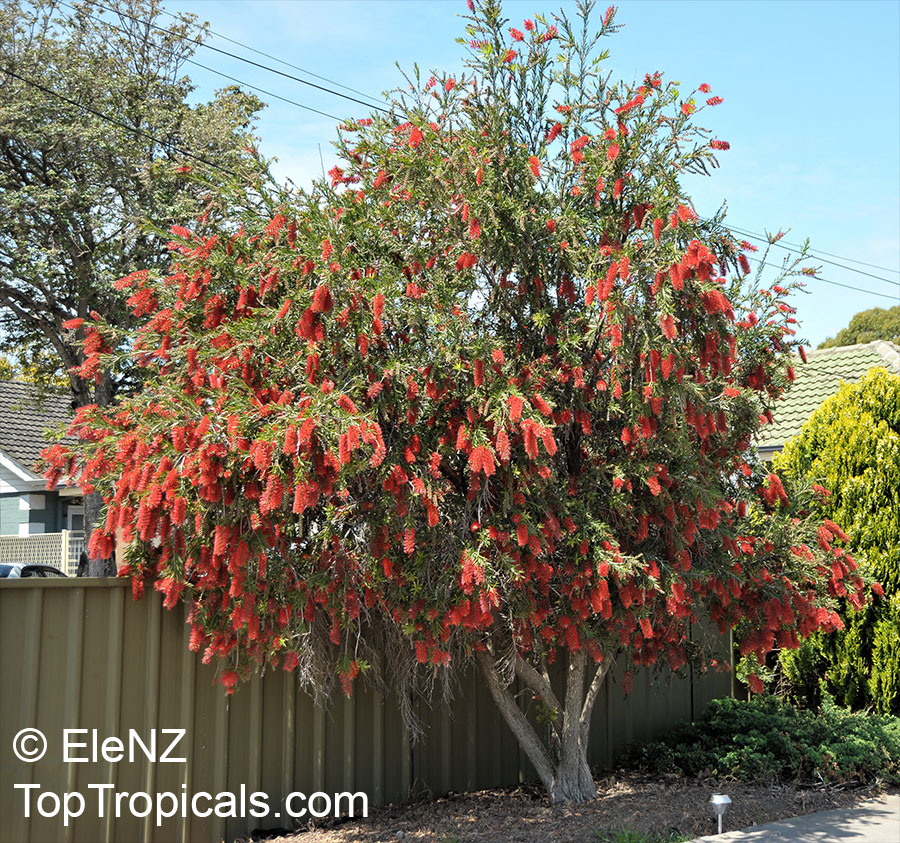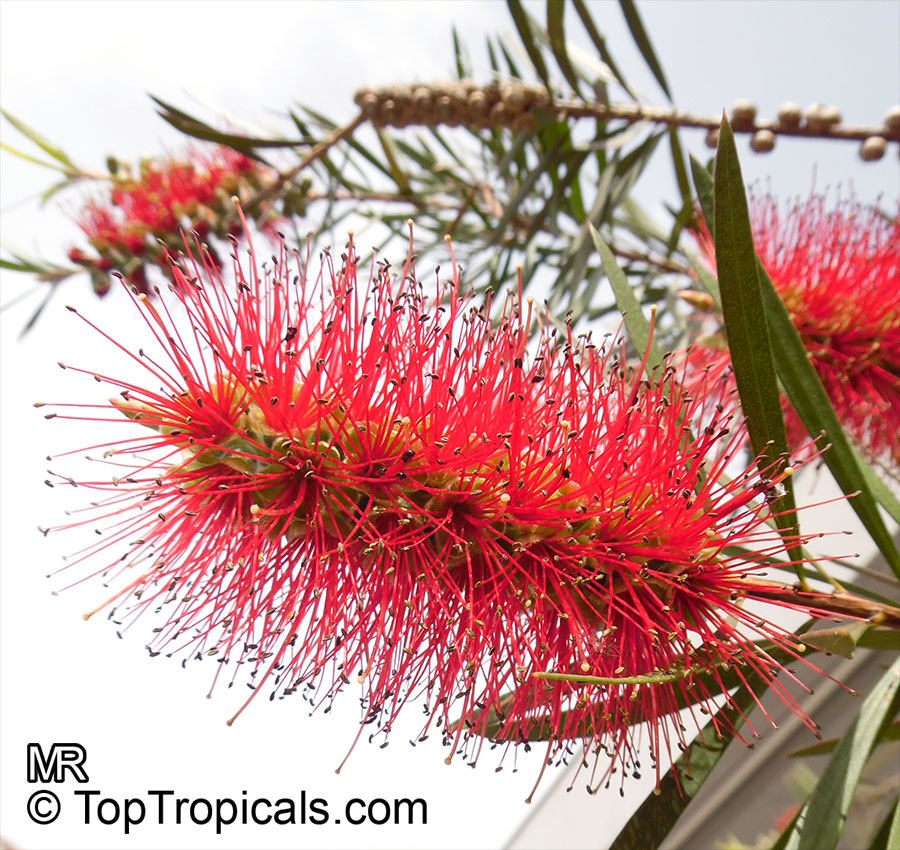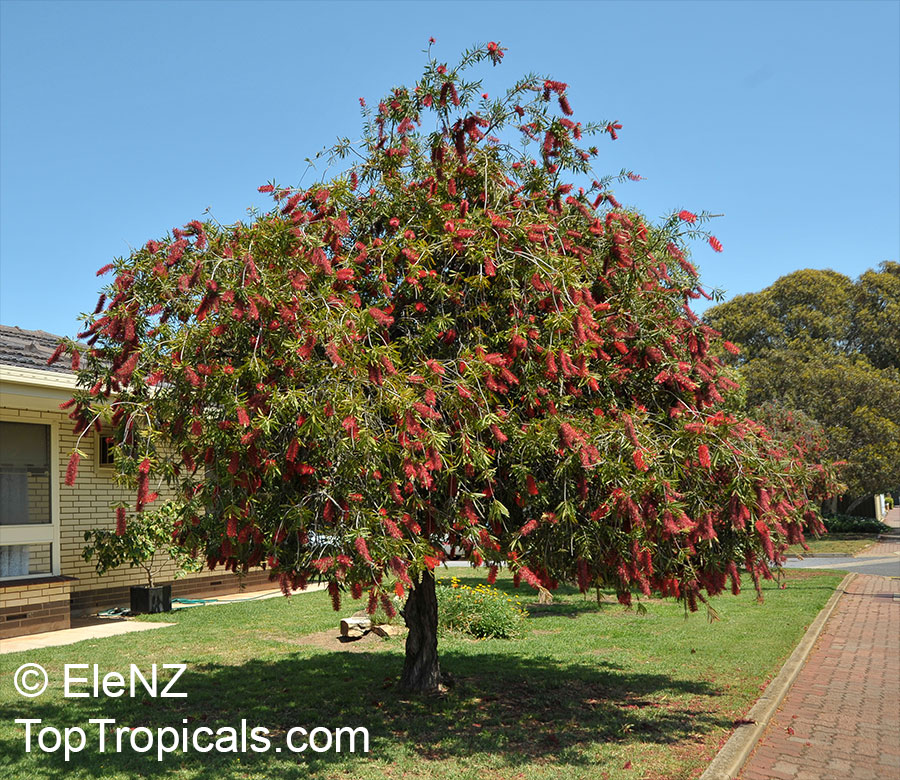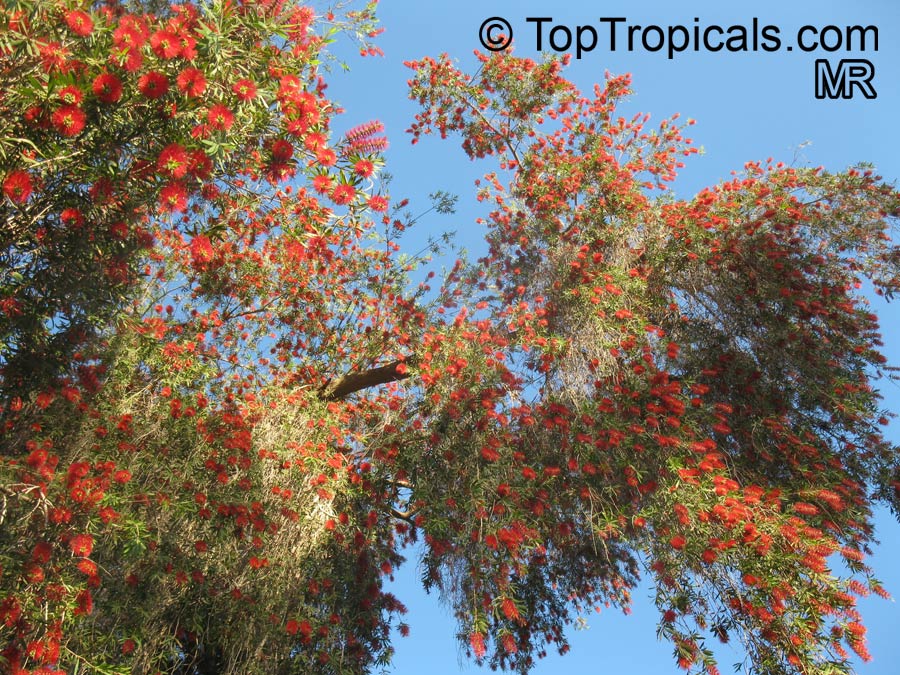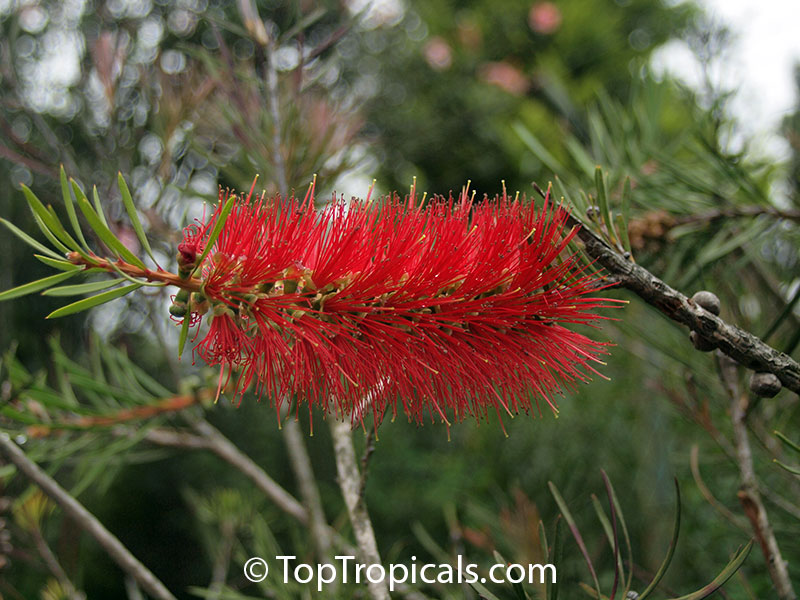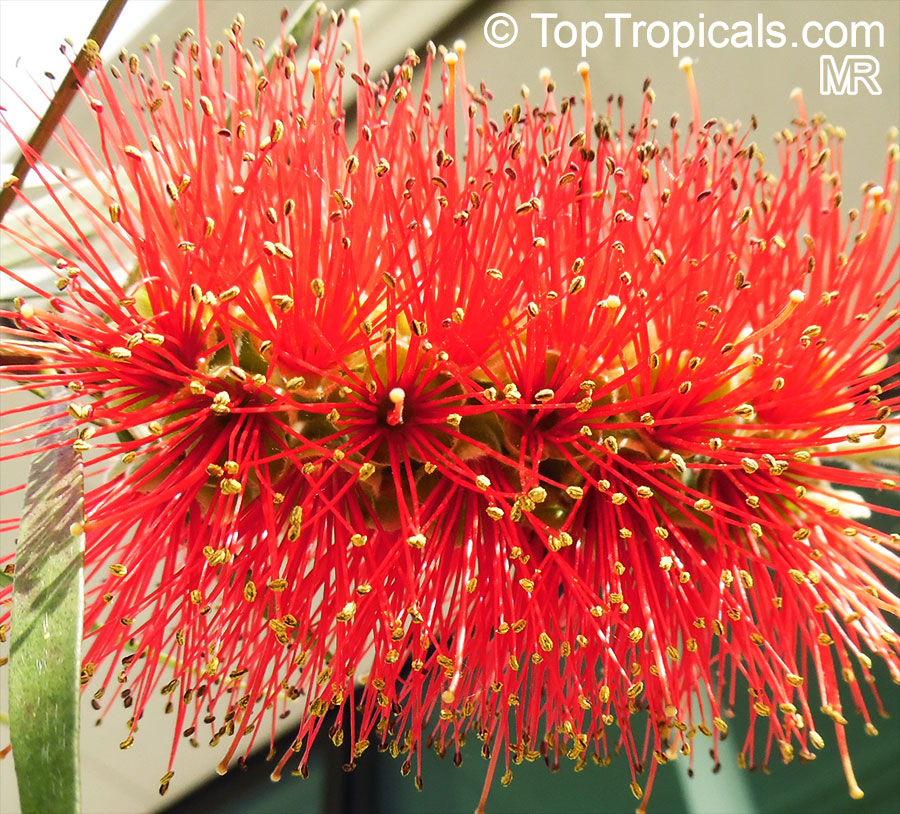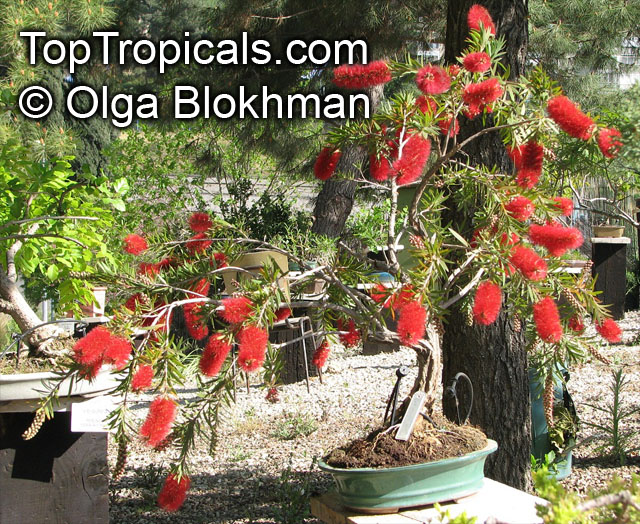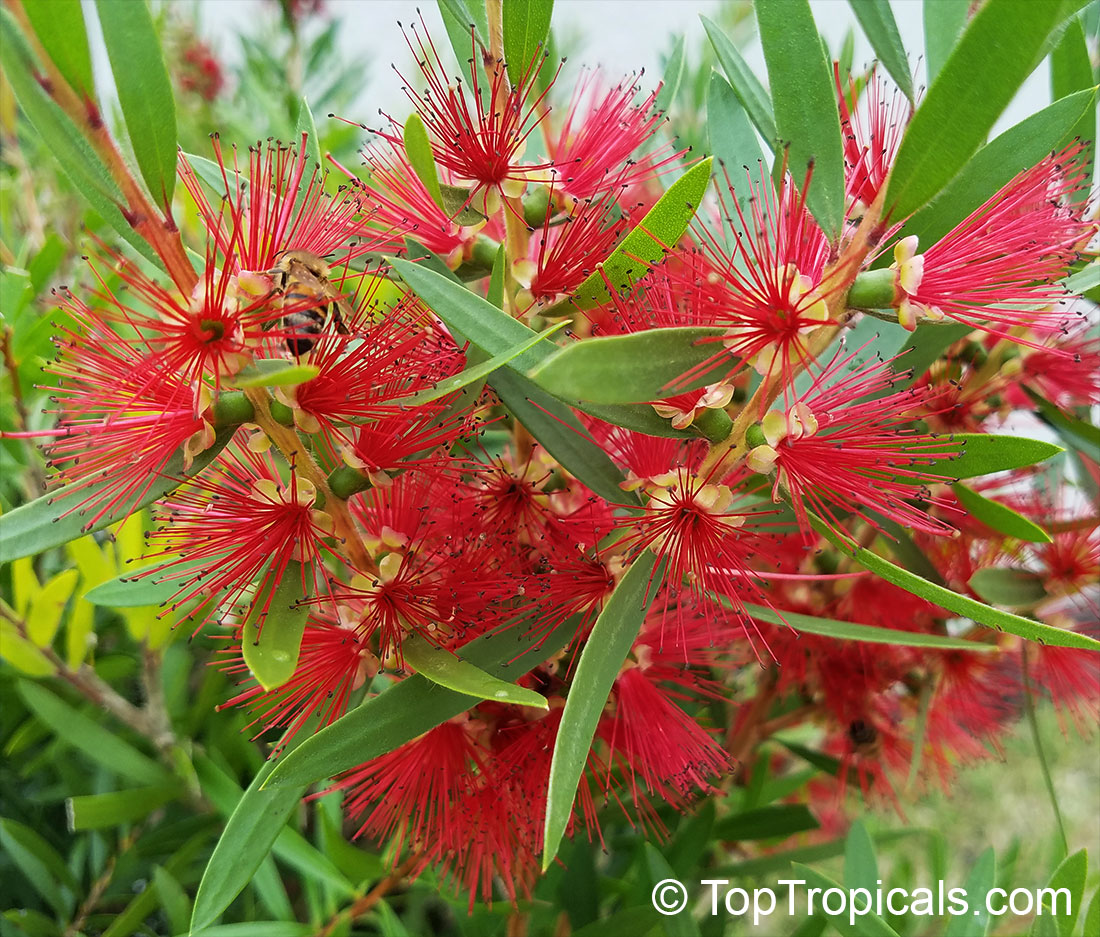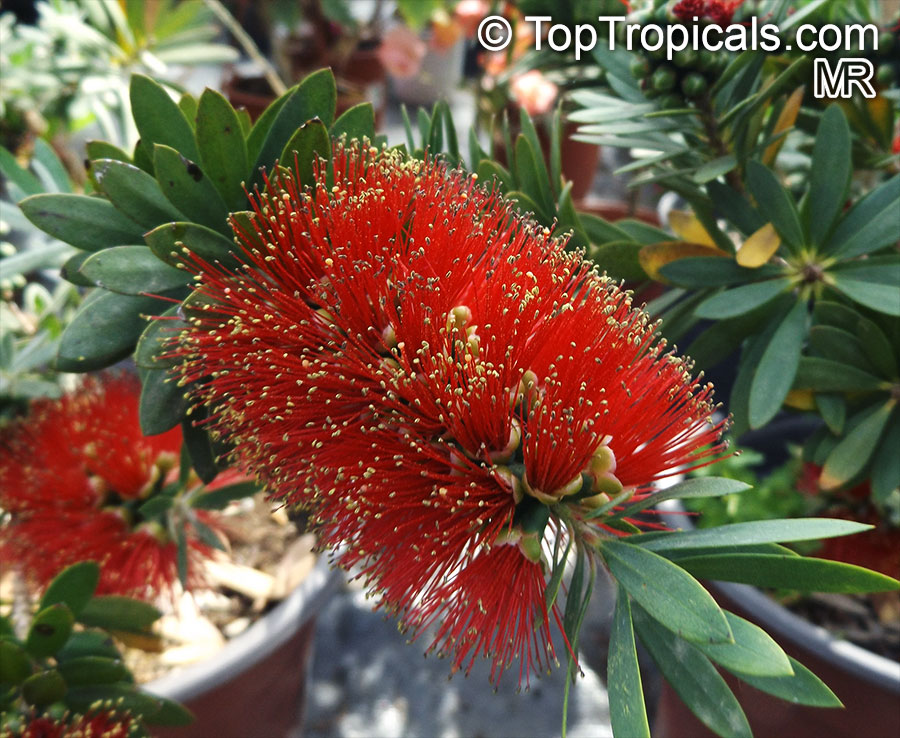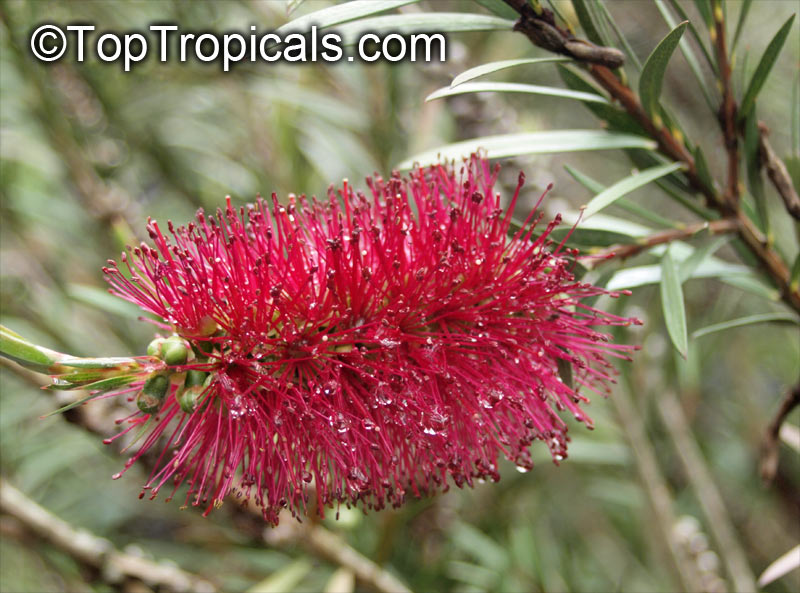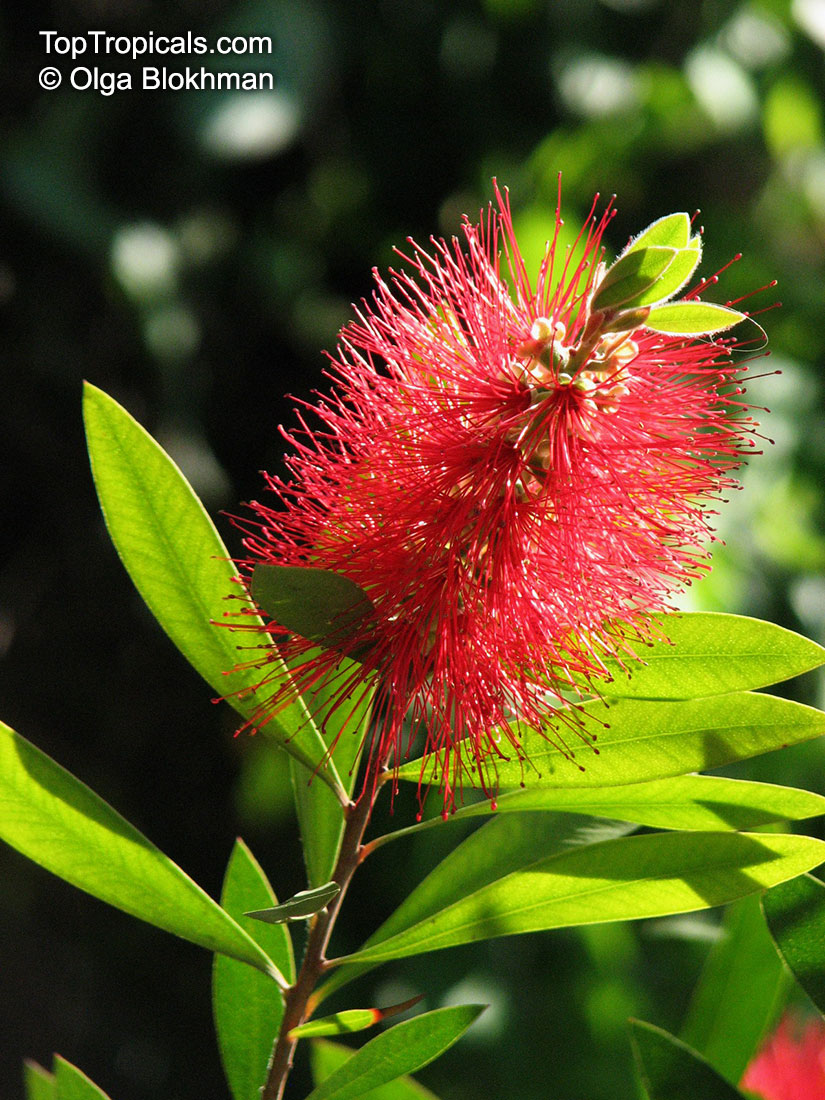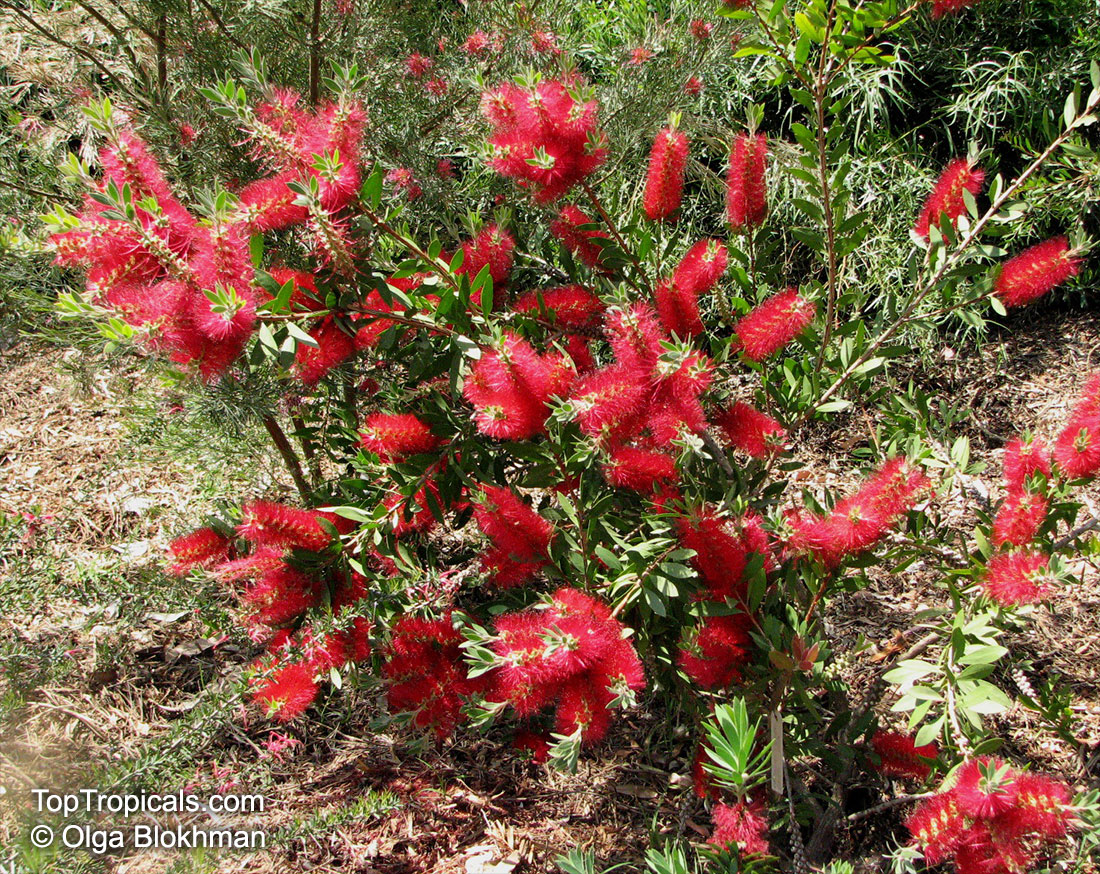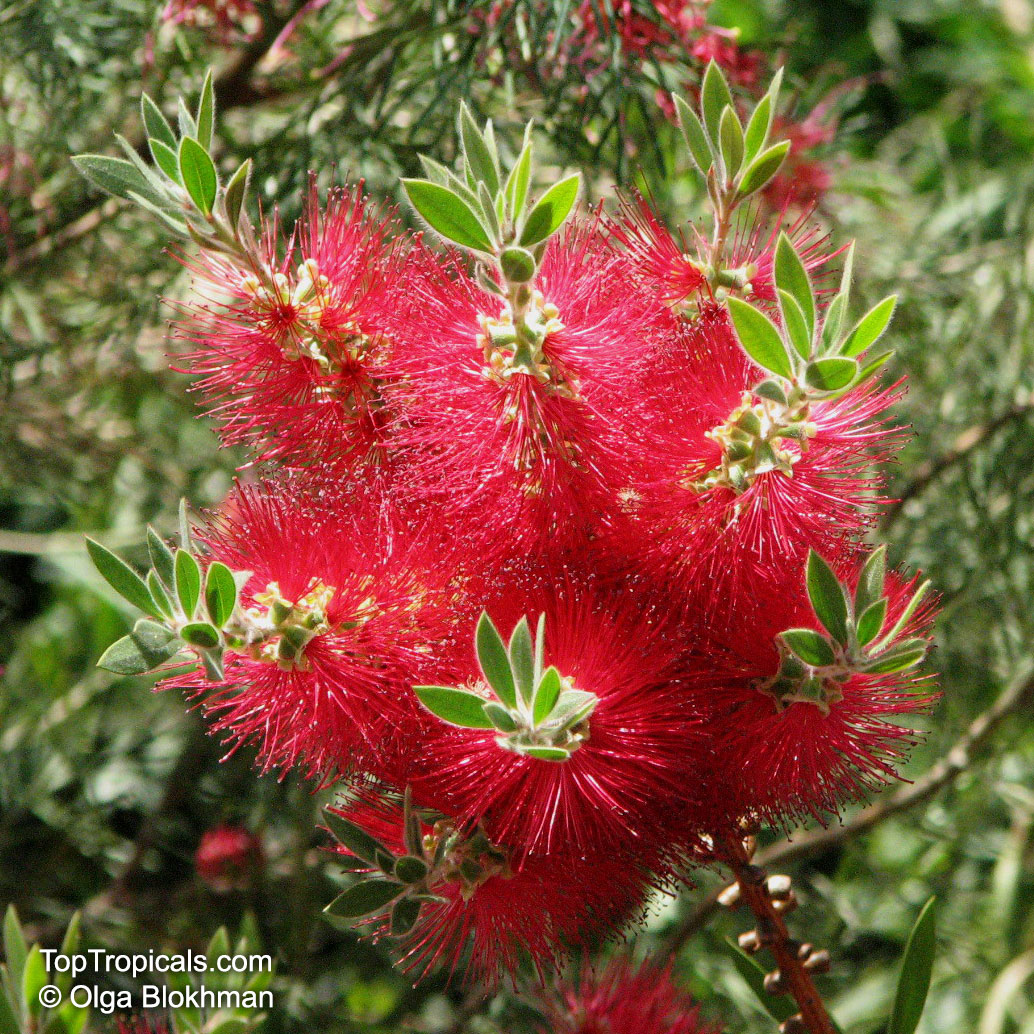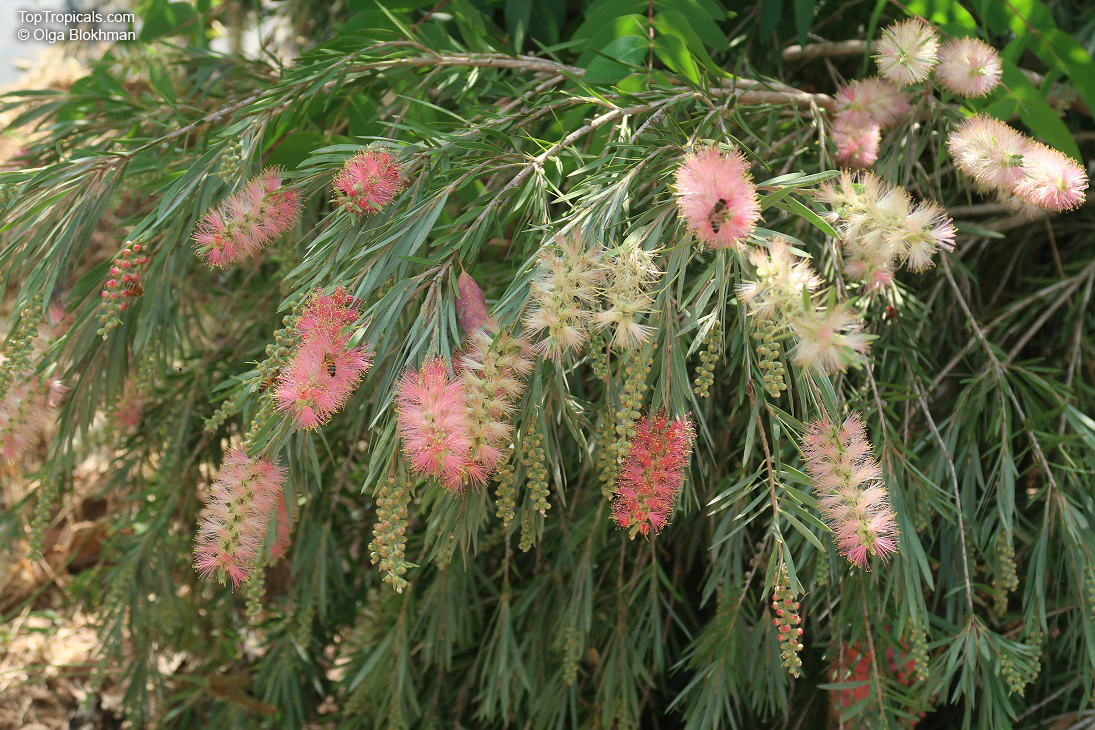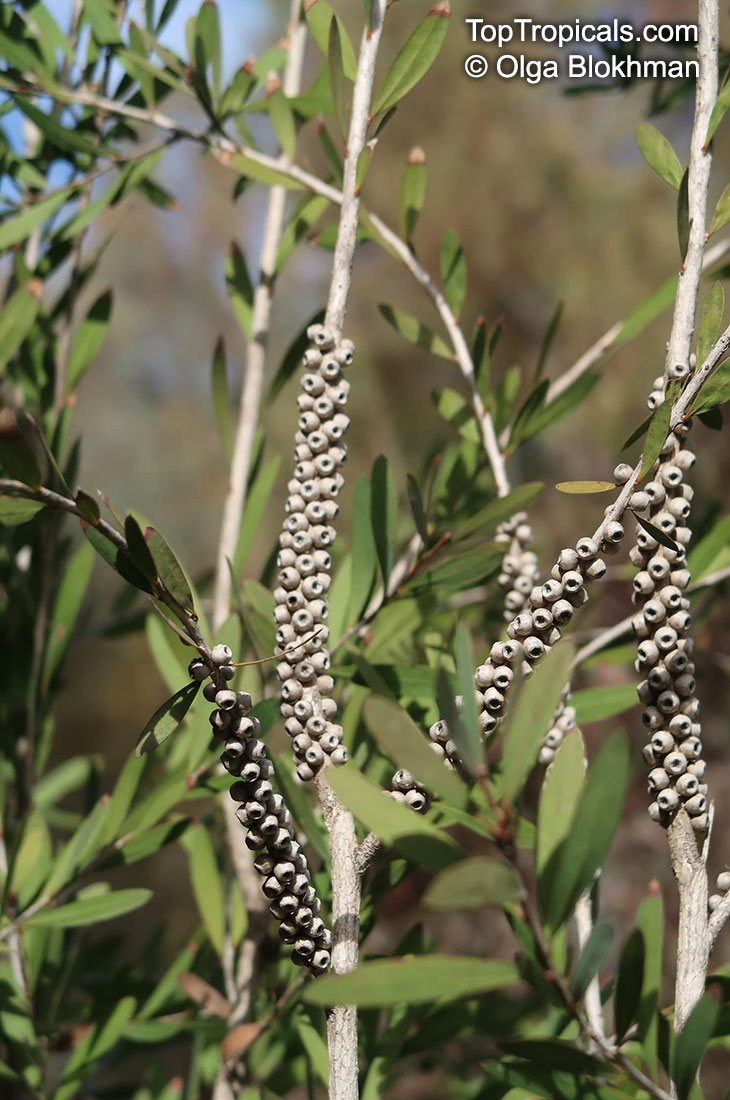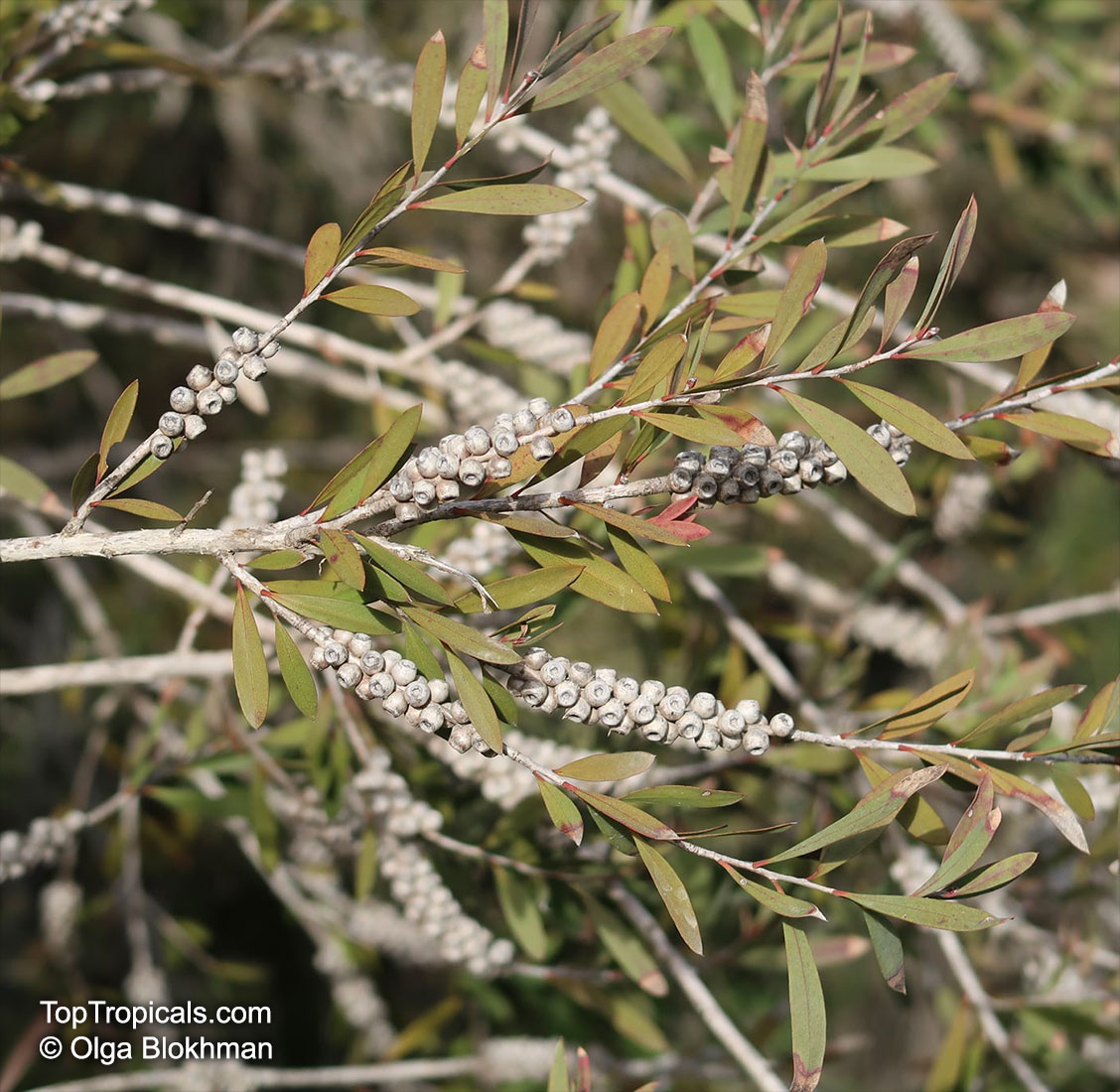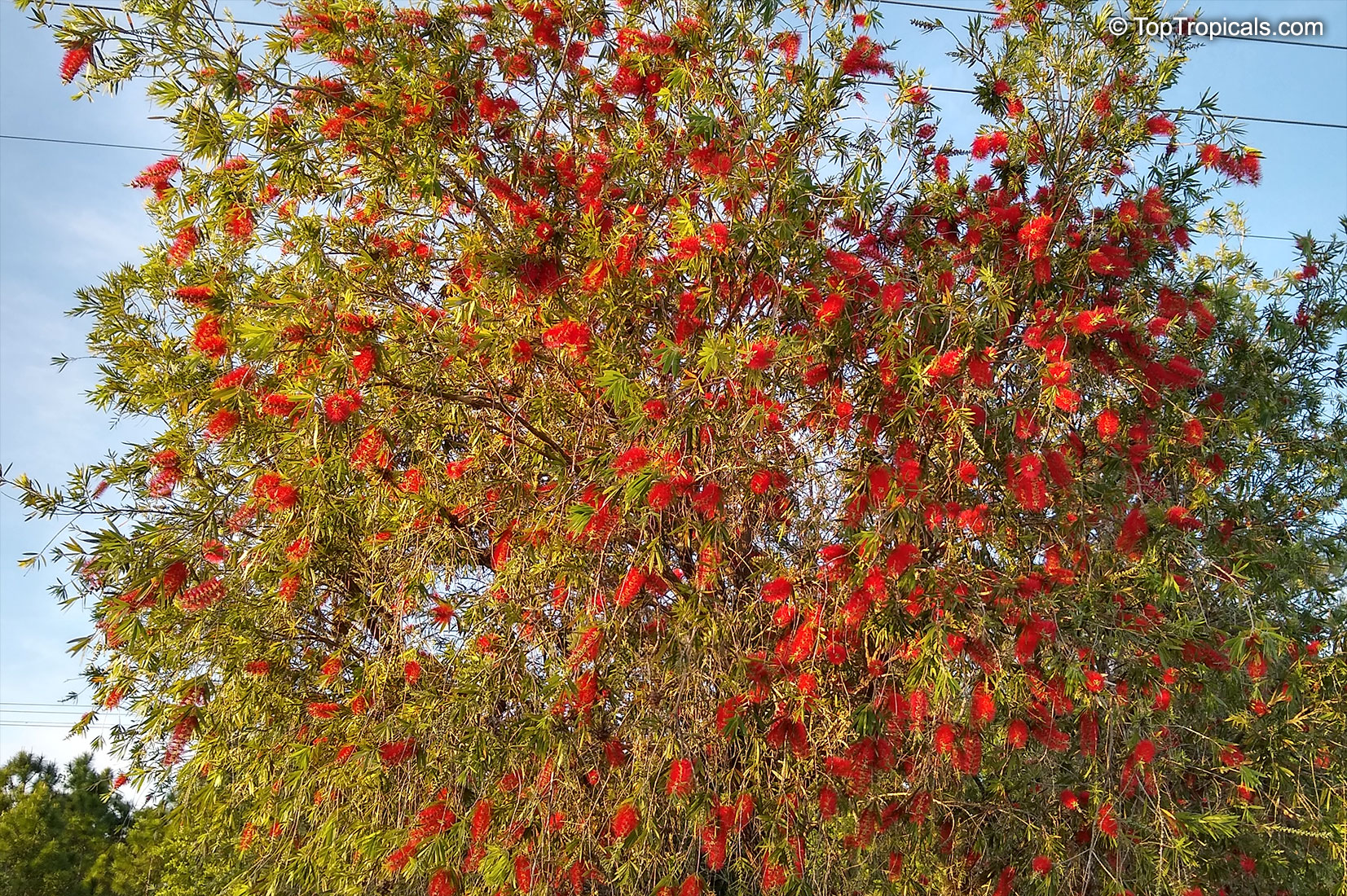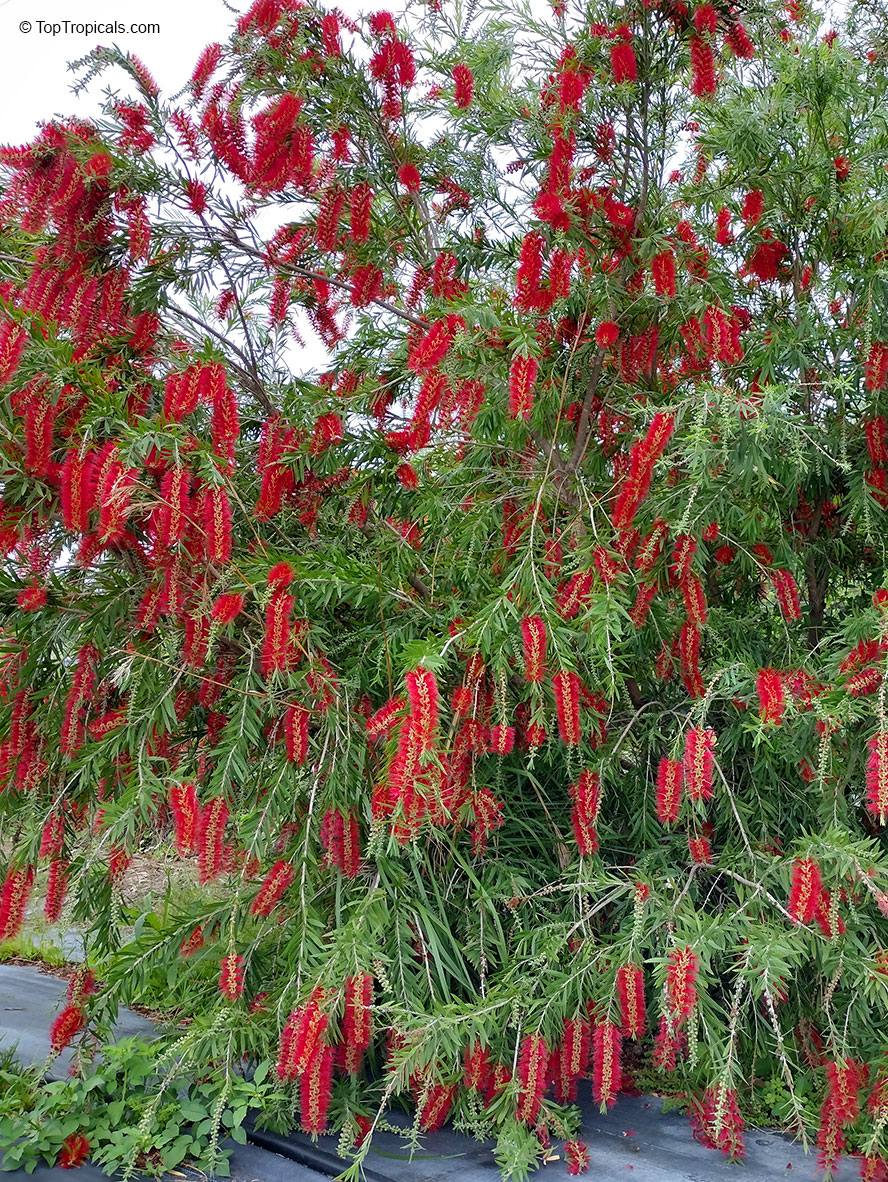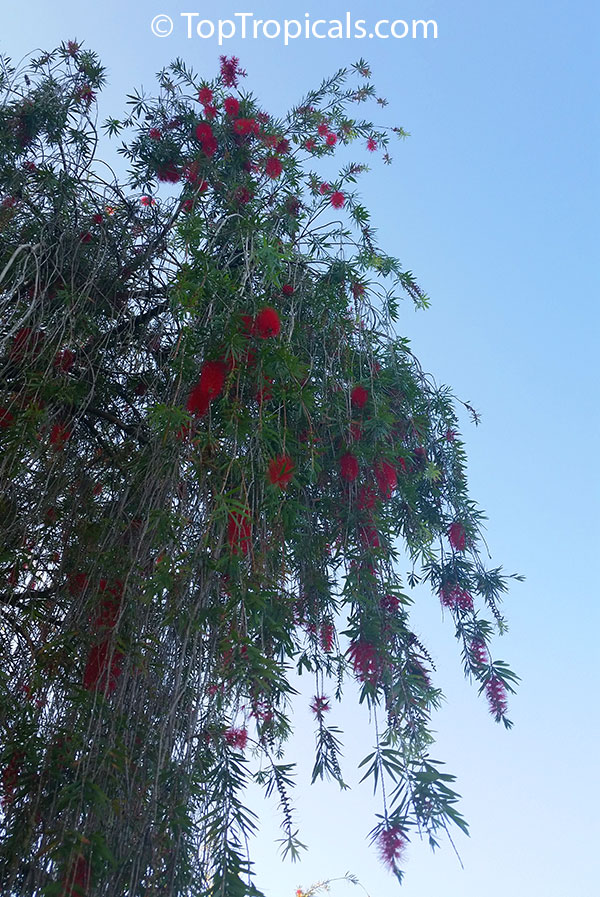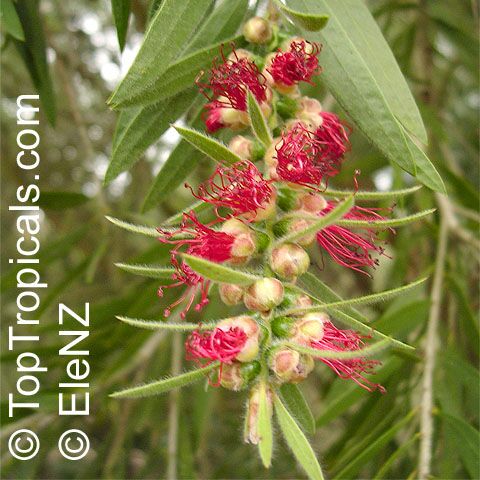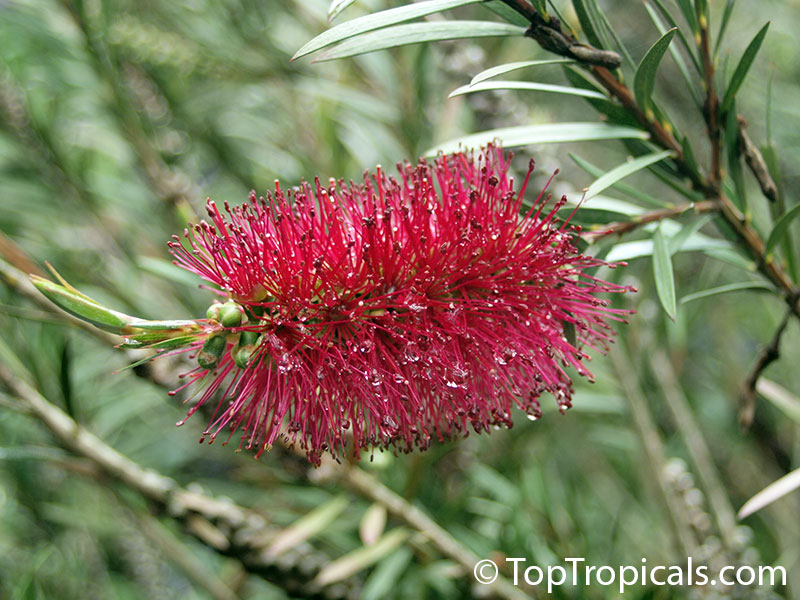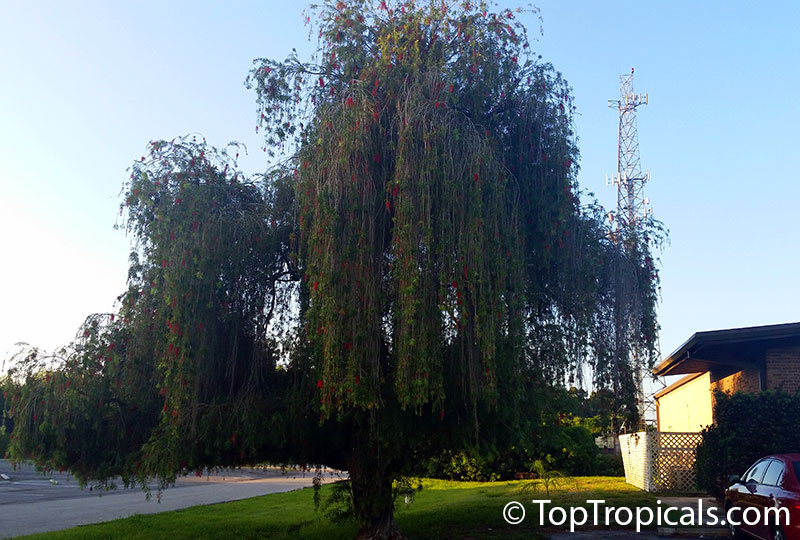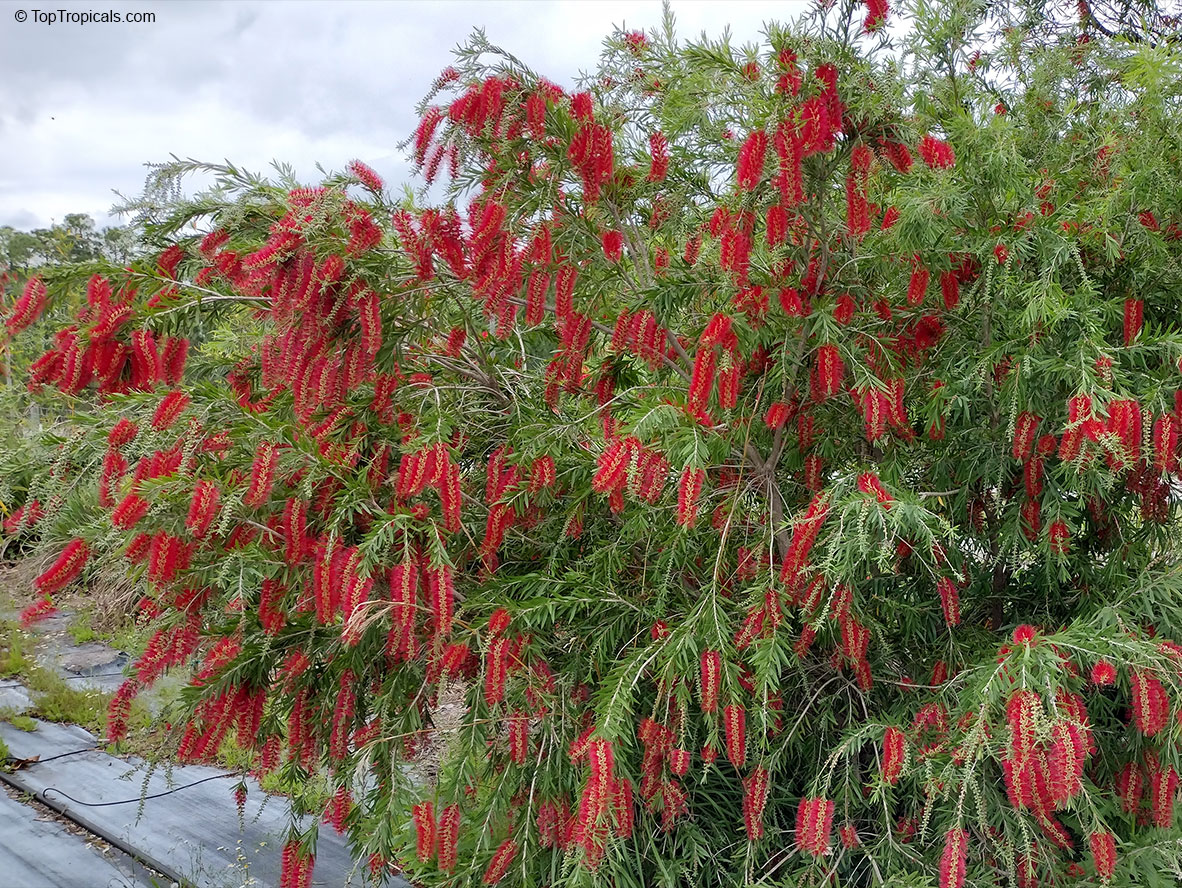Myrtaceae - Botanical Family
Top Tropicals Plant Encyclopedia
| Number of plants found: 123 | Next | 
|
Go to page: | 1 | 2 | 3 | 4 | 5 | Last |
Botanical name: Actinodium cunninghamii
Common name: Swamp Daisy
Family: Myrtaceae
Origin: Western Australia








Actinodium cunninghamii, also known as the Swamp Daisy, is a small plant that can grow up to 2-5 ft in height. A native to Western Australia, it is an evergreen shrub that is popular for its white and off-white flowers. In rare cases the flowers may bloom in a range of colors including red, crimson and vinous.
This small flower is also popular for its ability to attract butterflies and hummingbirds. It is tolerant of both dry and moderately wet environments. To grow well, Actinodium cunninghameii needs good soil drainage and should be watered regularly. It is tolerant of both full sun and semi-shade but it is important to ensure that it is kept moist in warm climates.
Actinodium Cunninghameii is hardy to USDA Zone 9-11. In cooler climates, it should be planted in a sheltered area to protect it from cold winds and frost. If container planting in a colder climate it is important to keep the soil moist but not too wet. A mulch can be used to help keep the roots from getting too cold in the winter.
Overall,Actinodium cunninghameii is a low-maintenance species that is suitable for a wide range of climates. With good soil drainage and enough sunlight, it will thrive in both warm and cold climates. Its easy to care for nature makes it an ideal choice for gardeners looking to add some colorful variety to their garden.
Botanical name: Agonis flexuosa
Common names: Willow Myrtle, Western Australian Peppermint
Family: Myrtaceae
Origin: Australia







Native to Western Australia, this small tree is excellent for small urban spaces, growing 10-20 ft in height and 6-15 ft in spread. It has an upright habit with an open, sparse crown. Agonis flexuosa (Willow Myrtle) has an attractive foliage of broad green leaves with a smooth texture. In summer, the tree is covered with white to off-white, fragrant flowers that attract bees and other beneficial insects. When blooming, its flowers give the tree a soft, romantic look.
This is a hardy drought-tolerant tree - once established, it only needs moderate amounts of water compared to other trees. Agonis flexuosa can tolerate salt, making it suitable for seaside gardens or areas exposed to salt spray. It performs best in full sun to semi-shade and is frost-hardy, growing well in USDA Zone 8-11.
When planting Agonis flexuosa, the soil should be well-drained, not too heavy and with a neutral pH. If you choose to grow it in a pot, you should use a well-draining potting mix, water frequently and add a layer of mulch as it helps to keep the roots cool and moist. In cold regions, it's best to keep the pot in a sheltered or sunny spot during the winter months to protect it from frost and cold winds.
Overall, Agonis flexuosa is a low-maintenance, versatile species that adds beauty and texture to any garden. Its fragrant flowers, attractive foliage and hardiness make it an ideal choice for temperate gardens that require a small, hardy tree.
Botanical names: Angophora costata, Angophora lanceolata
Common names: Smooth-barked apple, Rose Gum, Rose Apple, Sydney Red Gum
Family: Myrtaceae
Origin: Eastern Australia




The genus Angophora is very close to Eucalyptus, and can be distinguished easily by its opposite leaves. The old bark is shed in spring in large flakes with the new salmon-pink bark turning to pale grey before the next shedding. The tree has a handsome, rugged ornamental appearance and its young red tips are often used in floral arrangements.
Botanical name: Asteromyrtus symphyocarpa
Common names: Liniment Tree, Waria-waria Tree
Family: Myrtaceae
Origin: Australia, New Guinea









Plant produces therapeutic essential oils similar to Eucalyptus oil.
Botanical name: Baeckea latens
Common name: Baeckea
Family: Myrtaceae
Origin: Australia




They are small shrubs closely resembling Leptospermum.
Botanical name: Beaufortia sparsa
Common name: Swamp bottlebrush
Family: Myrtaceae
Origin: Western Australia







Beaufortia sparsa is a small to medium shrub to about 2 - 3 metres high. The leaves are oval shaped and about 10 mm long, bright green in color. The orange to red flower clusters occur towards the ends of the branches, their size and color making for a spectacular sight. Plants are more successful in drier climates. The species should be grown in well drained conditions in full sun or dappled shade and it is tolerant of at least moderate frost.
Botanical names: Blepharocalyx salicifolius, Eugenia salicifolia
Common name: Murta
Family: Myrtaceae
Origin: Brazil





Botanical name: Callistemon comboynensis
Common names: Cliff Bottlebrush, Comboyne Bottlbrush
Family: Myrtaceae
Origin: Australia








Callistemon comboynensis (Cliff Bottlebrush) is a plant native to Australia, and can be used for bonsai. It grows up to 5-10 ft tall, forming a large shrub. This small Callistemon species is a spreading shrub up to 10 ft high, with copper colored new growth and narrow, elliptical leaves. Flowers are usually dull red brushes up to 4 inch, attracting butterflies and hummingbirds.
In order to get the most out of this plant, its best grown in full sun and requires well drained, damp soil that can range from sand, loam, or clay, can tolerate neutral to alkaline soil and should be pruned after its flowering has finished. Moderately frost tolerant, Callistemon comboynensis is attractive for a container plant, growing well in USDA Zone 9-11.
In terms of growing and plant care, this species prefers regular water and thrives in full sun to semi shade. For colder regions in which this plant is grown in a pot, it should be protected from harsh winter winds and provide shelter from extreme temperatures. These conditions allow the Callistemon comboynensis to take advantage of its beauty and fragrant flowers with bold colors of red, crimson and vinous.
Botanical name: Callistemon sp.
Common name: Bottlebrush
Family: Myrtaceae
Origin: Australia










Withstands extended waterlogging and limited dry periods. Very showy. The flower spikes of bottlebrushes form in spring and summer and are made up of a number of individual flowers. The pollen of the flower forms on the tip of a long colored stalk called a filament. It is these filaments which give the flower spike its color and distinctive 'bottlebrush' shape. The filaments are usually yellow or red, sometimes the pollen also adds a bright yellow flush to the flower spikes. Each flower produces a small woody fruit containing hundreds of tiny seeds. These fruits form in clusters along the stem, and are usually held on the plant for many years. The seeds are usually not released from the fruits for several years, but in some species the fruits open after about a year. Fire also stimulates the opening of the fruits in some bottlebrushes. The new leaves of many bottlebrushes are very ornamental. The leaves are often colored and, in some species, they are covered with fine, soft hairs. Bottlebrushes make excellent garden plants. The flowers can be spectacular and are irresistible to nectar-feeding birds and insects. Most species are frost tolerant. They grow well in a wide variety of soils, except those which are highly alkaline. Plants grown in full sun produce the best flowers. Plants can be lightly pruned after flowering to keep them in shape. A low-phosphorous fertilizer should be applied in spring and autumn. Mulching will help retain soil moisture and reduce weed growth. Many cultivars have been selected from natural variants and hybrids between species. Some of these are very good garden plants. Other species: Callistemon brachyandrus, Prickly Bottlebrush - the tips of the small red flower-spikes are covered in yellow pollen. Callistemon formosus, Kingaroy Bottlebrush -lemon-colored flower . Callistemon salignus, Willow Bottlebrush - the flower-spikes are generally white or greenish but pink, red and mauve forms can be found. Callistemon subulatus- this compact shrub grows from 1 to 9Ft tall . Callistemon subulatus is a freely flowering plant which produces red flower spikes over summer.
Learn more:
From Bottlebrush to Little John, or the story of a Dwarf Plant
See Article about this plant.
Learn more: How to grow Bottle brush trees.
Recommended Fertilizer: SUNSHINE Megaflor - Bloom Nutrition Booster
Botanical name: Callistemon viminalis
Common name: Bottlebrush
Family: Myrtaceae
Origin: Australia









Callistemon viminalis (Bottlebrush) is a small tree, native to Australia, that grows between 10-20 feet tall. This beautiful tree has clusters of vibrant and dainty white, off-white, red, crimson and vinous flowers, with colors of yellow and orange. As the flowers mature, they become bottle brush shaped, hence the name. The beautiful blooms are sure to attract butterflies, bees and hummingbirds to your landscape.
This plant is hardy in USDA Zones 9-11, making it a great choice for warmer climates. It has a moderate water requirement and prefers full sun to partial shade. A mature Bottlebrush is known to be cold hardy at least to 30s F for a short time, making it a good choice even in colder climates as long as it is provided with a bit of extra protection such as a North-facing wall or backyard fence. It is also flood and salt tolerant, making it a great choice for seaside landscapes.
When it comes to growing and caring for Bottlebrushes in a pot, they will do well in large pots that have good drainage. During cold winter months, the pot should be placed in a sheltered location, preferably against a wall that gets plenty of sun. It is important to keep the soil moist during the spring and summer months and to water it less in the winter. When planting Bottlebrush in a pot, use well-draining soil and a pot with drainage holes. Additionally, it is a good idea to use a pot that is larger than the existing rootball and to check the roots from time to time to ensure they are not pot-bound. Fertilizer can also be added to the pot to help the growth of the tree.
By following the recommended planting and caring instructions, you can be sure that the Bottlebrush will thrive in your landscape or pot. With its vibrant colors and ease of care, this beautiful tree and its bottle brush-shaped flowers are sure to be an eye-catching addition to your landscape and a great attraction for butterflies and hummingbirds.
| Next |  |
Use link to repeat this search:
https://toptropicals.com/cgi-bin/garden_catalog/cat.cgi?search_op=and&keyword_op=and&language=e&family=Myrtaceae&number=10
&no_change_lang=1&user=tt&sale=1&first=0
